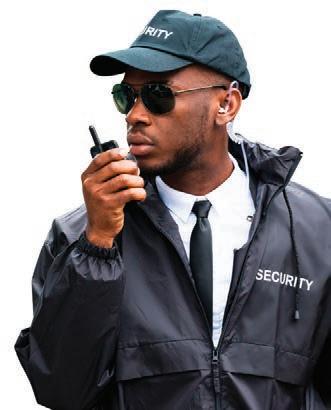Denied the right to vote, P. 14

Chicago-style coalition building is alive and well by DMB (D-M Brown), P . 8

Denied the right to vote, P. 14

Chicago-style coalition building is alive and well by DMB (D-M Brown), P . 8
05 Style Chicago Fashion Week begins.
06 Feature RICE is a new monthly meal series and art collective creating community through South Asian cuisine.
07 Reader Bites Cesar’s hand-stretched applewood-smoked string cheese from the Cheese People
08 Brown | Cover story Throughout Chicago’s history, organizers from different backgrounds have united behind common goals.
12 Surveillance The CTA is betting on a new AI gun detection tool.
14 Elections Voting rights for formerly incarcerated people
16 Feature Musician Eiren Caffall on her debut memoir
18 Review Leasho Johnson’s folklore-inspired paintings
20 Exhibitions of Note Solo shows at Patron and the International Museum of Surgical Science
22 Review Colectivo El Pozo’s Elvira takes an allegorical approach to the story of an immigration rights activist.
23 Plays of Note Ironbound at Raven Theatre and El Piélago de las Calamidades at Teatro Tariakuri
24 Feature Mr. Man celebrates ten years of male nudity onscreen.
25 Moviegoer Sole searching
26 Feature The Hyde Park Jazz Festival faces down uncertainty with defiant artistry.
28 The Secret History of Chicago Music Influential folk singer Jo Mapes deserved better from the music business.
30 Shows of Note Previews of concerts including Ravyn Lenae, Anohni & the Johnsons, and MJ Lenderman & the Wind
34 Gossip Wolf Isaiah Collier retires the Chosen Few with a fiery new record, Kaicrewsade expands his soulful vision with his first mixtape, and more.
CLASSIFIEDS
33 Jobs
34 Professionals & Services


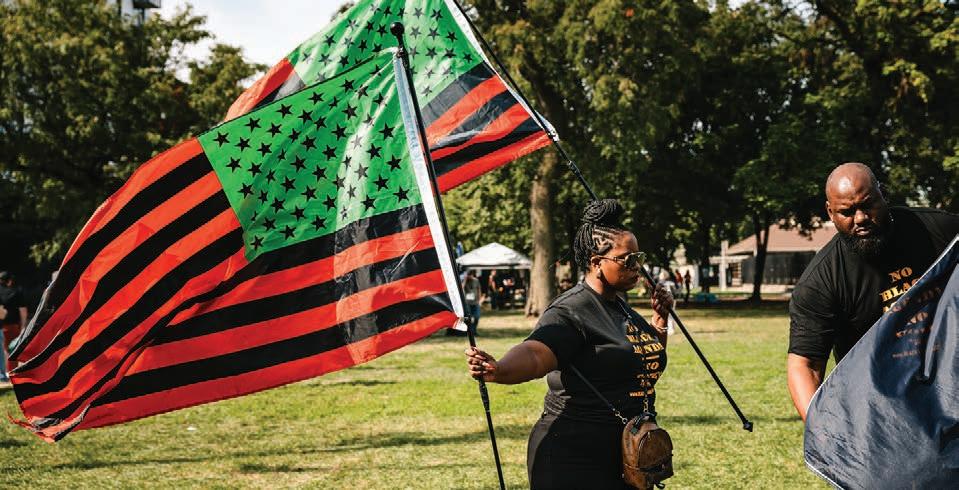
CEO AND PUBLISHER SOLOMON LIEBERMAN
ASSOCIATE PUBLISHER AMBER NETTLES EDITOR IN CHIEF SALEM COLLO-JULIN
MANAGING EDITOR SHEBA WHITE
ASSISTANT MANAGING EDITOR
SAVANNAH RAY HUGUELEY
ART DIRECTOR JAMES HOSKING
PRODUCTION MANAGER KIRK WILLIAMSON
SENIOR GRAPHIC DESIGNER AMBER HUFF
GRAPHIC DESIGNER AND PHOTO RESEARCHER
SHIRA FRIEDMAN-PARKS
THEATER & DANCE EDITOR KERRY REID
MUSIC EDITOR PHILIP MONTORO
CULTURE EDITOR: FILM, MEDIA, FOOD & DRINK TARYN MCFADDEN
CULTURE EDITOR: ART, ARCHITECTURE, BOOKS, LITERARY ARTS KERRY CARDOZA
NEWS EDITOR SHAWN MULCAHY
ASSOCIATE EDITOR & BRANDED CONTENT
SPECIALIST JAMIE LUDWIG
DIGITAL EDITOR TYRA NICOLE TRICHE
SENIOR WRITERS LEOR GALIL, DEANNA ISAACS, BEN JORAVSKY, MIKE SULA
FEATURES WRITER KATIE PROUT
SOCIAL JUSTICE REPORTER DMB (D-M BROWN)
STAFF WRITER MICCO CAPORALE
MULTIMEDIA CONTENT PRODUCER SHAWNEE DAY
SOCIAL MEDIA ENGAGEMENT
ASSOCIATE CHARLI RENKEN
EDITORIAL INTERN LAYLA BROWN-CLARK
VICE PRESIDENT OF OPERATIONS ANN SCHOLHAMER
VICE PRESIDENT OF PEOPLE AND CULTURE
ALIA GRAHAM
CHIEF PRODUCT OFFICER BRIAN BOYER
OPERATIONS ASSOCIATE LINDLEY FRENCH
CHIEF DEVELOPMENT OFFICER JIM STRUTHERS
DEVELOPMENT MANAGER JOEY MANDEVILLE
DATA ASSOCIATE TATIANA PEREZ
DIRECTOR OF MARKETING AND STRATEGIC COMMUNICATIONS CHASITY COOPER
MARKETING ASSOCIATE MAJA STACHNIK
MARKETING ASSOCIATE MICHAEL THOMPSON
VICE PRESIDENT OF SALES AMY MATHENY
SENIOR SALES REPRESENTATIVE LINDSAY FIGURSKI
SALES REPRESENTATIVE WILL ROGERS
DIGITAL SALES ASSOCIATE AYANA ROLLING
MEDIA SALES ASSOCIATE JILLIAN MUELLER
ADVERTISING
ADS@CHICAGOREADER.COM, 312-392-2970
CREATE A CLASSIFIED AD LISTING AT CLASSIFIEDS.CHICAGOREADER.COM
DISTRIBUTION CONCERNS
DISTRIBUTIONISSUES@CHICAGOREADER.COM 312-392-2970
READER INSTITUTE FOR COMMUNITY
JOURNALISM, INC.
CHAIRPERSON EILEEN RHODES
TREASURER REESE MARCUSSON
SECRETARY TORRENCE GARDNER
DIRECTORS MONIQUE BRINKMAN-HILL, JULIETTE BUFORD, JAMAL DEGERATTO, DANIEL DEVER, MATT DOUBLEDAY, TIMO MARTINEZ, JAKE MIKVA, ROBERT REITER, MARILYNN RUBIO, CHRISTINA CRAWFORD STEED
READER (ISSN 1096-6919) IS PUBLISHED WEEKLY BY THE READER INSTITUTE FOR COMMUNITY JOURNALISM 2930 S. MICHIGAN, SUITE 102 CHICAGO, IL 60616 312-392-2934, CHICAGOREADER.COM
COPYRIGHT © 2024 CHICAGO READER ALL RIGHTS RESERVED. CHICAGO READER, READER, AND REVERSED R: REGISTERED TRADEMARKS ® TO CONTACT ANY READER EMPLOYEE, EMAIL: (FIRST INITIAL)(LAST NAME) @CHICAGOREADER.COM
The company’s pioneering sustainable vertical strawberry farm allows fruit to be grown to peak quality all year round.
There’s nothing like the sensation of biting into a perfectly ripe, juicy strawberry. But in colder regions like Illinois, peak harvest season for the delicious red berries lasts only a few weeks. That means the bulk of fresh strawberries available locally throughout the year are shipped from other states and countries. In an era where climate change and population growth has made traditional agriculture increasingly unsustainable, that adds up to uneven quality, taste, and nutrition—and generates an enormous carbon footprint.

That’s where Oishii is different. The New Jersey–based company combines the traditions of Japanese fruit culture, where strawberries are associated with celebration, with visionary technology to revolutionize the produce industry and raise the bar for fresh fruit in the United States. At their 237,000-square-foot state-of-the-art indoor vertical farm, Amatelas Farm (named for the mythical Japanese goddess of the sun), they grow pristine, luscious, Non-GMO
compared to their tart and bright American counterparts. The seeds are cultivated by the company’s in-house propagation lab, where Oishii’s expert team grows them into seedlings that are then transferred to the company’s indoor farms, which have been meticulously designed to replicate the ideal growing conditions of Japan. Everything is monitored, including temperature, humidity, carbon dioxide, windspeed, and light, right down to the perfect number of bees.
Oishii’s farmers nurture the plants every step of the way as they flower and produce fruit, using timehonored Japanese farming techniques and cutting-edge technology. Ninety-nine percent of the water used is recycled through their multimillion dollar water purification system, while robots analyze 60 billion data points annually and help harvest the berries at their peak ripeness. This results in a strawberry that is estimated to be one-and-a-half to two times as sweet as the average supermarket variety while ensuring maximum quality all year round.

Project Verified and pesticide-free strawberries 365 days of the year. The results have wowed top restaurants and chefs in the Northeastern US, and this month, for the first time, Oishii brought their delectable Koyo Berries to the greater Chicagoland area, where they will be available for purchase at select Whole Foods Markets.
It all starts with the humble seed. Oishii focuses on Japanese strawberries, which are known for their luxuriously sweet flavor and fragrant aroma
The Koyo Berry originates from just outside Tokyo. Its slightly firm texture and refreshing sweetness make it an excellent choice for breakfasts, salads, mocktails, desserts—or any other dish that could use a burst of freshness. And in keeping with Japanese tradition, they make a fantastic addition to any special occasion or an anytime gi for strawberry lovers of all ages.
As Oishii begins to dazzle Chicago’s taste buds, the company is one step closer to fulfilling its mission of bringing the most delicious strawberries to people all over the world. Learn more at oishii.com or stop by a Whole Foods Market to purchase a pack today. Just take one bite, and you’ll realize the future of strawberries is here.
This sponsored content is paid for by





Re: “Thrashing around,” on Northwestern University professor Steven Thrasher, written by Deanna Isaacs and published in the October 3 issue (volume 54, number one)
When you see Ta-Nehisi Coates being called an “extremist” by a white CBS host for simply writing about what he saw, it is clear that institutional powers in the U.S. do not want any sort of objectivity, but only a parroting of their ideology.
—Robin Tierney, via X
Why isn’t there more outrage? How is it that the people speaking out against horrors are treated so harshly . . . or [those] supporting the commission of those horrors are allowed to act with impunity?
—Laura Ross, via X
In the olden days, the so-called establishment was reactionary, chickenshit, and dull, but it generally fell short of being fascist. I can’t believe what I’m seeing, and then, the next day, I’m seeing something else. Unbelievable. 1968 would like a word.
—Molly Gordon, via X
WTF. Do better, NU!
—Saralynn Pablo, via LinkedIn
Find us on socials: facebook.com/chicagoreader twitter.com/Chicago_Reader instagram.com/chicago_reader threads.net/@chicago_reader linkedin.com search chicago-reader
The Chicago Reader accepts comments and letters to the editor of less than 400 words for publication consideration. m letters@chicagoreader.com




Let me set the scene from the past so you can appreciate the Freaky Friday transformation that’s turned Chicago politics upside down.
The next election in the City of Chicago provides an opportunity to weigh in on who our next American president will be, for sure, but there are also statewide referendums, county positions, judges, and school board members to vote on.
City of Chicago residents can find out in two ways. It’s fastest to go to chicagoelections.gov and fill out the Voter Information Lookup form on the homepage with your name and address. A warning that the name lookup is exact to the spelling that you originally registered with (so those with hyphens or other symbols in their names may want to search under a few options if you don’t find yourself at first). You can also call the Board of Election Commissioners at 312-269-7936 to confirm. The online tool also allows you to register address updates or name changes.
New voters and new Chicago residents can register online at ova.elections.il.gov, the Illinois State Board of Elections website. You must have a valid and unexpired Illinois driver’s license or state ID to register online. You can also use this service to change your name or address.
Online registration closes Sunday, October 20, at 11:59 PM
You can also register to vote in person at all Early Voting sites, or at your precinct polling place on Election Day. You will need to show two forms of ID, and one must list your current address. Accepted forms of ID include a valid and unexpired U.S. passport, a work or school ID, a LINK or Department of Human Services card, or an Illinois FOID card. v

There we were, me and Peter Cunningham, heading for Bronzeville (never mind why) with Peter behind the wheel. We were doing what we always do: debating politics. In this case, we were debating school board politics.
It was 2014. Mayor Rahm (Peter’s longtime friend) was firmly in charge of the city, including the schools.
Karen Lewis (my friend) was leading a nascent movement for an elected school board and diminishing the mayor’s control of the schools.
Peter, who once wrote speeches for Mayor Daley, was vehemently arguing against an elected school board, saying you can’t demand mayoral accountability without allowing mayors to control policy and spending.
And I was ranting and raving about tyrannical mayors and their rubber-stamp boards taking on boneheaded loans and siphoning millions from the classrooms for TIF-funded boondoggles.
board independence. Turns out that Reader guy, Ben, was right!
(OK, they’ll never go that far.)
In short, a dramatic transformation. Am I Peter now, and is Peter now me?
I will let the honorable Mr. C. speak for himself when he guests on my podcast this week. But speaking for myself . . .
As much as I want Mayor Johnson to succeed, I believe he’s overplayed his hand.
Yes, the mayor’s correct when he says we’ve inadequately funded our public schools and that we need more money for teachers and sta .
But I don’t think the way to raise those funds is with high-interest loans that basically take money from the classrooms and give it to bankers. Instead, I believe we should move heaven and earth to help elect Kamala Harris. And then press her for more federal funding for schools.

Our great debate raged from roughly Irving Park Road to 47th Street and only ended when we reached our destination.
Here we are, all these years later, and . . .
Mayor Johnson, once an organizer in Karen’s movement, wanted the school board to fire CEO Pedro Martinez and borrow hundreds of millions to hire more teachers, counselors, and librarians and give the current staff a raise.
Johnson’s fighting so ferociously that the old board resigned en masse, rather than get between the mayor’s feud with Martinez.
Now the mayor’s appointing new board members who will apparently do what he says.
Meanwhile, Chicago’s corporate, civic, and editorial elites are up in arms, decrying the mayor’s moves as a power play. As are almost all the alderpeople.
Tyranny, they called it. No more payday loans, they demanded. It’s time for school
After all, it was President Biden who kept our schools funded over the last few years. And, absolutely, the state should also kick in more. It’s about time that Democrats practice the values they profess.
That said, I take no comfort from these born-again reformers who have suddenly become adherents to the cause. They were nowhere to be found when both Mayor Daleys and Rahm ruled the land.
Back then they said we need a powerful mayor to rule a tough city. Now they want a weakened mayor so they can beat him in the next election with a centrist or right-winger. Anyone will do.
They’re pretending they give a damn about borrowing and board independence, exploiting the controversy to help unseat Johnson, put the teachers union in its place, and go back to the way that things were.
Strong mayor, rubber-stamp boards, bad budgets, and all. v
—Ben Joravsky, senior writer m bjoravsky@chicagoreader.com
Chicago Fashion Week seeks to attract global attention to the city’s local designers.
By MAIA MCDONALD
An international spotlight will focus on Chicago’s fashion scene this month as the inaugural Chicago Fashion Week (CFW) kicks o a nearly two-week-long schedule of events throughout the city.
CFW celebrates Chicago’s contributions to the global fashion community and the city’s growth as a hub of internationally recognized designers and premiere fashion schools. The series of events showcases runway shows, gallery exhibitions, presentations, vintage shopping markets, award shows, galas, and more, in partnership with local and national fashion organizations, retailers, and neighborhood business associations.
The series of events and exhibitions is the first City of Chicago–endorsed, multiday, fashion-focused series with the name “Chicago Fashion Week,” though there have been similar Chicago-focused fashion public projects in the past. The most frequently cited predecessor is Fashion Focus Chicago, a series created in 2005 by former mayor Richard M. Daley’s administration to support the city’s local fashion industry through runway shows and other presentations. Decreased funding at the city’s Department of Cultural A airs and Special Events (DCASE) for the production of Fashion Focus Chicago resulted in its final showing in 2015.
Many involved in CFW believe it to be a return by the city to the honoring of Chicago’s historic roots in fashion and related industries.
“The difference with Chicago Fashion Week, and I can really say this because I know it hasn’t happened before, is we are much expanded from that footprint. So [Fashion Focus Chicago] laid a fantastic foundation for us to build upon,” said Carrie Lannon, a communications consultant and CFW’s event producer.
CFW was first announced in May at a press event by Mayor Brandon Johnson and event

organizers. “Chicago is, and has been, a cultural hub when it comes to arts, entertainment, and fashion,” Johnson remarked at the event. “We have a vast collection of world-class fashion designers, but unfortunately they have not gotten the attention that they deserve. That is about to change.”
CFW’s leadership team includes Lannon along with CFW founder John Leydon, and Chicago Fashion Coalition president Marquan Jones. The team joined forces with a steering committee featuring several fashion industry professionals to program daily events throughout the city and in suburbs like Evanston and Highland Park.
The Chicago Fashion Coalition, the Curio, the Costume Council of the Chicago History Museum, and other fashion organizations also collaborated with the team to fill the schedule, which began with an opening show at the Chicago Cultural Center.
Hosted by the Curio, a local fashion organization aimed at highlighting Chicago designers and fashion throughout the entire year with initiatives like the Chicago Fashion Calendar, the opening event was planned as a runway show featuring a diverse range of eight local designers—Barbara Bates, Chelsea B., Christina Karin, Gente Fina, I Am Studios, Justin LeBlanc Design, Maria Pinto, and Sheila Rashid—whose

work includes streetwear, evening wear, and other styles.
“All the designers that we’re showcasing, the eight of them, are Chicago-based. They range in age and how long they’ve been on the fashion scene,” said Ian Gerard, a cofounder and principal of the Curio.
“We’re trying to showcase the best of Chicago fashion because, obviously, this is Chicago Fashion Week,” Gerard continued. “I think a lot of the other events are going to focus on Chicago fashion, but many of them also mix in designers from other places, but just to kick it o . . . it’s all about Chicago.”
CFW organizers are also committed to making sure the events are not just accessible to designers and those already embedded within the fashion community, but the city’s residents as well. Nearly 95 percent of the events happening through October 20 are open to the public, and several are free to attend.
Lannon says while many other fashion week events tend to be more industry-focused, showcasing what industry veterans and established brands can expect to be bought and sold during the next season, CFW was intentionally designed to be more consumer-friendly. Several events place guests in the same room with actual designers and provide the public with opportunities for personal styling or
shopping.
“Chicago Fashion Week in Chicago is for consumers, and we decided early on that everything should be available to the public,” Lannon said.
The Curio principal Maggie Gillette also believes that CFW is a good opportunity to showcase what sets Chicago apart from other major fashion hubs around the globe. The city was home to world-renowned street style icons like the late Virgil Abloh, for example, and has a unique focus on sustainability and small-batch manufacturing in the wake of the dissolution of the city’s once-thriving garment industry.
Gillette said that CFW is a prime opportunity for consumers to discover smaller local brands, who can use the multiday event to increase brand awareness.
“Go to something in your neighborhood, you may find that you really have an a nity for some of these designs,” said Gillette. “And, you know, there’s no risk [in] going to a free event. All that can happen is you can find out something cool.” v
This story was abridged for space in this print edition. A full version, along with a list of CFW events, is viewable at chicagoreader.com. m letters@chicagoreader.com


The new monthly meal series and art collective is creating community through South Asian cuisine.
By CHARLIE KOLODZIEJ
Iwas served up RICE—an art collective and curated meal series celebrating South Asian cuisine—by the magic of the Instagram algorithm. After being gifted a copy of food columnist Meera Sodha’s cookbook Made in India, I went down a social media rabbit hole of Indian cooking videos. Up popped one of RICE’s posts on my Explore page, which described their goal: to blend food with poetry, film, and performance. The collective wants to have the kinds of introspective conversations traditionally reserved for the echoey walls of a gallery, only they want to have them in their own homes, over warm bowls of rice.
I messaged RICE cofounder Ankit Khadgi— whose exhibition on the history of Chicago’s queer South Asian community I had recently
seen at Bronzeville’s South Asia Institute—and a few weeks later, I was making the CTA trip from Uptown to Hyde Park for the collective’s inaugural meal. When I arrived, Khadgi greeted me at the building’s front door and took me upstairs to the kind of Hyde Park apartment I’ve seen a million times over in di erent iterations: a cozy living room, a bedroom on either side, and a tidy kitchen, with plants and lots of natural light. I felt instantly at home.
As more guests trickled in, we passed around a pitcher of starchy rice water and green tea, a RICE collective invention somehow both bitter and refreshing. Once everyone arrived and settled in—about ten of us spread across two tables and the floor—another RICE cofounder, Khytul Abyad, welcomed us to the space: a
friend’s apartment they were subletting while looking for permanent housing. “Matamaal” was the theme of RICE’s inaugural meal, Abyad told the group, a word that in their native Kashmiri means “grandmother’s house.” Each collective member had prepared a dish inspired by memories of their grandmother’s cooking. We were all invited into the kitchen, where we were greeted by a warm bowl of saag paneer, a pan of aloo tama, and, of course, a heaping platter of flu y rice. Khadgi had made the aloo tama, an indigenous Newa dish made with potatoes, bamboo shoots, and black-eyed peas. It is often served during festivals in Kathmandu, Nepal, where Khadgi’s family has lived for generations.
Khadgi’s aloo tama soon prompted a conversation about how the stories behind our foods change as recipes move across time and across cultures. Even with all the same ingredients, re-creating your grandmother’s magic in the kitchen? Good luck.
Conversations like these are the reason RICE was founded, says Khadgi, who I chatted with for some months after the collective’s first dinner, along with their RICE cofounders, Abyad, Moakshaa Vohra, and Sayera Anwar. “We want people to come together and have conversations around food, and also sort of make them aware about the kind of food that we as South Asians grew up eating,” says Khadgi.
Members of the collective each represent di erent cultures across southern Asia: Abyad is from Kashmir, Anwar from Pakistan, Vohra
For their RICE version of the dish, Khadgi used canned bamboo shoots he picked up at Jewel-Osco. Back home, these would ordinarily be sold fresh, he told us, giving them a more tangy, almost sour taste. “When you can’t find the traditional ingredients here in the U.S., you have to use whatever is available to you,” said Khadgi. He added extra lemon to give the aloo tama the sourness it was missing.
from India, and Khadgi from Nepal. “While there are a lot of similarities in our food and in our culinary cultures, there’s also a lot of differences and a lot of uniqueness,” says Khadgi. “Through this collective, we are also trying to share those recipes with a larger audience and bring people of di erent backgrounds and di erent cultures together to the same table.”
The collective first met while completing their graduate studies at the School of the Art Institute of Chicago. Each far from the cultures they grew up in, the four friends began to share recipes that reminded them of home. Eventually, the group decided to formalize their meals into RICE, a meal series that would combine their respective art practices with their love of traditional South Asian cuisine.
“One thing that’s been really consistent is that people go up to us [after our meals] and say the food is very homey, which is the point of having this collective, for people to come together and feel like they are at home,” says Abyad.
The goal is not to have restaurant-quality food, she added, and if that’s what you want, you can take your pick of South Asian joints across the city. Instead, RICE’s food is warm in the way it can only be when prepared in the small kitchen of a Chicago flat, the kind of apartment you’ve likely shared meals in across the city. The dinner chairs are mismatched and so are the glasses, but none of that matters, because the food and the company are cozy, comforting, and refreshingly relaxed. This is not the watered-down butter chicken you’d pick up from a chain restaurant after a busy day at work. “It’s a very well-known saying, and kind of an overused saying in Bollywood in India, that the way to your heart goes through your stomach,” says Abyad. “We believe in that.”
Kashmir. Spread across the dinner table was a tablecloth featuring one such creature, the Yachch, a magical entity that arrives in the dead of winter to dig graves. Abyad made the textile piece as part of a printmaking class at Ox-Bow School of Art in Michigan this past winter.
This fusion of food, art, and poetry is part of RICE’s grand way of experimenting with the limitations traditional arts institutions put around food, says Vohra, the group’s informal arts administrator. Art and food don’t traditionally mix, says Vohra, even though the latter can spark the same conversations one might have around a beautiful film or painting. She’s right on both counts, of course. Despite the modern rebranding of the culinary arts, food in creative spaces is still typically confined to the depressing cheese-on-sticks of an art show opening.
“When we invite people into our home, it means we have invited them into our hearts.”
The star of RICE’s second meal, held this past September, was a chicken and potato biryani, a dish traditionally reserved for celebratory occasions across South Asia. “Borderlines” was this meal’s theme, and biryani was chosen because of its ability to transcend the state-imposed borders of the region. There are close to 200 varieties of the dish spread across the countries that RICE represents, says Abyad, and everyone fights over whose culture has the best recipe. “We knew that biryani was one thing all of us had in common. . . . We have like 20 biryani stalls in my neighborhood,” she says.



Cesar’s hand-stretched applewood-smoked string cheese from the Cheese People
“Nbite. Eating strings of such cheese is about as satisfying as eating thread.
The Cheese People have changed my fundamental understanding of the comestible that is string cheese. When I finally make my way to the front of the line, I can’t help gushing about my love of the smoked version as the cheesemonger gathers my order. “It’s hand-stretched,” he tells me. “That stu is the best.”

Halfway through RICE’s inaugural meal, Abyad read a poem she had written in response to the dinner’s “Matamaal” theme, in which she has an imaginary conversation with her grandmother. “One of the recipes for our dinner today is my naani’s palak tsaman, ‘palak and paneer,’” she read. “Naani taught this recipe to her daughter, my mom, who in turn taught it to me.” The poem went on to recount the stories Abyad’s naani used to tell her about the mythical creatures of her native
In line with the meal’s theme, the collective also screened two short films from Anwar and Khadgi that reflect on crossing cultural and political borders. Khadgi’s film, titled saree not sorry , follows a conversation between Khadgi and a close friend about how both grew more comfortable in their identities as queer South Asians. Khadgi’s friend talks about the joy they found in wearing sarees, meticulously adorned dresses traditionally worn by women across South Asia. The table setting for RICE’s second meal included a collection of sarees from the RICE cofounders.
By preparing traditional meals, Khadgi is already crossing a cultural boundary in Nepali culture, one that confines cooking to the arena of “women’s work.” Having only
o cloud cover,” mumbles the man behind me. It’s a sweltering Saturday at the Evanston Farmers’ Market, and we’re deep in line, a line that’s growing before my eyes—28 people, then 29. As always, I’m glad my first stop at the market is the Cheese People. There’s strategy to my beelining; I’ve circled back to the Cheese People before, hoping that while I pick out purpling heirlooms and knobbly kohlrabi, the line will dwindle. In fact, the line for the Cheese People never dwindles, but their prime offering, Cesar’s hand-stretched applewood-smoked string cheese, does. As I inch closer to the tent, I strain to hear others’ orders—I watch cheesemongers knife samples of Alpine-style cheddar, a semihard sheep’s milk—and I breathe relief every time a customer leaves without a bundle of smoky, ropy string cheese heaven. If you’re like me, you didn’t realize string cheese could be heaven. String cheese, in my experience, was a blunt cylinder of bland, part-skim mozz, without bang or
male cousins and siblings, Khadgi has taken on the responsibility of learning his mother’s and grandmother’s traditions in the kitchen, traditions that would otherwise be lost to time in the absence of female relatives to share them with.
For their upcoming dinner this October 13, the collective has chosen the theme “Michigama,” and they will showcase recipes and art that bear a spiritual connection to Lake Michigan. Anyone is welcome to attend, says
It really is. A hearty hunk of this string cheese (none of that wimpy stuff in shrink-wrapped plastic) has the snap of a cheese curd. (The Cheese People sell those too, fresh-milled.) It comes plain or smoked, and unless you’re allergic to applewood, you might as well do yourself a favor and get smoked. The exterior is a toasty gold—burnished, even—and each pull yields strings with serious chew. This is toothsome string cheese, string cheese that wants to be a player in the kind of meal you crave when it’s too hot to eat and you’ve been in the farmers’ market sun too long—call it a ploughman’s lunch. With a good Cortland apple and a hunk of salami? Perfection. Heaven. —JOANNA NOVAK THE CHEESE PEOPLE Farmers’ markets across Chicagoland from May–October, home delivery year-round, $16 per 3/4 pound, thecheesepeople.com v
Reader Bites celebrates dishes, drinks, and atmospheres from the Chicagoland food scene. Have you had a recent food or drink experience that you can’t stop thinking about? Share it with us at fooddrink @chicagoreader.com.
Anwar, RICE’s unofficially official photographer. When she first came to the States, Anwar often missed the sense of community she felt in her native Pakistan. RICE, she hopes, will be a space for her to grow that community in Chicago.
“When we invite people into our home,” says Anwar, “it means we have invited them into our hearts.” v
m letters@chicagoreader.com
Chicago organizers have long joined together across racial, ethnic, and geographic lines in the fight for a better city.
By DMB (D-M BROWN)
When the sun rose over Chicago on the first day of the 2024 Democratic National Convention, out-of-towners were undoubtedly impressed by the city’s downtown high-rises, jibaritos, and hot dogs, and protesters donned in keffiyehs and holding picket signs.
Tens of thousands of protesters representing issues from tenants’ rights to police abolition flooded the streets of the most segregated U.S. metropolitan city to tease out its impurities like a pressure washer. The U.S. Palestinian Community Network (USPCN) brought together a multitude of people from 300 organizations under the banner of the Coalition to March on DNC 2024 to show Democrats that enabling Israel’s genocide on Gaza would lose them their progressive voting bloc in the 2024 presidential election.
This Chicago-style coalition building is an age-old tradition, one that forges connections in direct opposition to narratives pitting communities against one another. The organizing that took over the city this summer offers a moment to pause and reflect on what coalitionbuilding has looked like over the years and what it has accomplished.
USPCN was founded in 2006 near the end of the second intifada—a period of major uprisings by Palestinians in Jerusalem, the West Bank, and East Jerusalem between 2000 and 2005—to build grassroots political power in Palestinian and Arab communities across the U.S. The organization has chapters in Los Angeles, the Bay Area, Milwaukee, Cleveland, the Detroit metropolitan area, New York City, and Washington, D.C. But its largest chapter, like the largest Palestinian American community in the U.S., is in Chicagoland.
Among USPCN’s founders are the late George Adib Khoury, who was active with the Detroit chapter of the Black Panther Party, and
others who worked on Harold Washington’s historic mayoral campaign and Jesse Jackson’s presidential run.
“There are these elders who have lived some of the most important history,” says Muhammad Sankari, who’s been organizing with the Chicago chapter for 14 years. “We never feel like we’re reinventing the wheel. . . . We are just taking [their] knowledge and experience and applying it to new conditions.”
USPCN has forged a close relationship with the Chicago Alliance Against Racist and Political Repression (CAARPR). In January, as the City Council geared up for a vote on a resolution in support of a ceasefire in Gaza, the groups worked together to flood the phones of Black and Brown alders with messages in support of the measure. And in 2020, amid nationwide uprisings against police violence following the murder of George Floyd, Arab American store owners stood armed on their shop rooftops, which were located in Black neighborhoods, to defend against potential looters. USPCN and CAARPR told store owners to go home and organized a caravan rally through Little Palestine to disavow the store owners’ responses

“That was distinctly to raise the call of Black Lives Matter in the heart of the Arab community,” Sankari says. “And to make a public pronouncement that this one thing that’s happened does not represent our community.”
“We can’t get anything done by ourselves.”
Starbucks Workers United (SBWU), among them burgeoning queer labor organizers, brought their baristas to the front lines of the March on the DNC. The Democratic Party, at face value, supports unions and worker movements. But members of SBWU Chicago understand the urgency of aligning themselves with workers both foreign and domestic.
“I’m a barista. Think of someone who works as a barista in Palestine,” says Lily Elling, who
works at a store in Greektown. “What are their working conditions right now? Think of someone who works as a mailman in Palestine. There’s a genocide being enacted on laborers in Palestine. It’s the same fight [as ours].”
As a member of the March on DNC Coalition, SBWU Chicago has connected with other labor unions like the United Auto Workers, which represents employees from Ford’s south-side factory, and regularly sends baristas to join their picket lines. UAW sends workers to support SBWU’s strikes, too.
SBWU has been in a nationwide fight with Starbucks for four years. But their employers only came to the table in the past six months, following mass public solidarity with Palestine. Consumers boycotted the company after a Starbucks union in New York faced legal backlash for tweeting a message in solidarity with Palestine in late 2023. The co ee
company’s stock has dropped more than 10 percent since the pro-Palestininan boycott started.
Organizers with MAMAS (Mamas Activating Movements for Abolition and Solidarity) joined the DNC Coalition to bring their feminist, reproductive justice–oriented, and abolitionist lens to the demonstrations. The group provides resources to a group of ten mostly Black and Latinx moms who are actively mothering and caring for incarcerated survivors of Chicago police torture and frame-ups. All of their sons have been jailed for at least a decade.
MAMAS has a long-standing relationship with the Palestinian Feminist Collective. Throughout the year, members of both organizations host dinners together, take part in direct actions at the Cook County Jail, and join together for strategy meetings.
MAMAS posted on Instagram a week before the convention announcing that they planned to show up and demand freedom for their kids, resources for their communities, and justice for mothers and families everywhere. Mothers in Palestine, says MAMAS associate director Erica Bentley, deal with a di erent face of the same beast. “The forces are learning from each other,” she says. “Our struggles are the same struggle.”
MAMAS mothers saw their kids jailed between 18 and 22 years old, and haven’t been able to experience that natural progression other mothers witness as their kids go from child to adult. Moms and sons miss out on shared developmental milestones like graduating high school and finding lifelong partners, and their relationship stays in a perpetual dynamic of the mother caring for their vulnerable child.
“If we’re looking at the ability to parent and raise children and families in a safe and
“We never feel like we’re reinventing the wheel. . . . We are just taking [their] knowledge and experience and applying it to new conditions.”
sustainable way,” Bentley says, “prison is the ultimate violation of that by the state.”
In the 1950s and ’60s, neighborhoods across Chicago were awash in segregation, police brutality, and inequality. Against this backdrop, community leaders from Kenwood to Pilsen to Uptown organized not just within their own neighborhoods but between neighborhoods, laying the groundwork for a multiracial socialist alliance the following decade.
At the invitation of 44 civil rights organizations, remembered as the Chicago Freedom Movement, Martin Luther King Jr. brought his civil rights crusade to Chicago in late 1965. King arrived at a time when organizing across the city was already happening. Using a 17-month campaign of boycotts, marches, and lobbying in the Windy City, King bolstered local efforts to desegregate schools and housing.
Following King’s assassination in 1968, Fred Hampton of the Illinois Black Panther Party capitalized on the growing momentum and fervor of the civil rights movement. He reached out to the Young Lords Organization, a former Puerto Rican street gang turned political organization, and working-class whites, known as the Young Patriots, to form perhaps one of the most formidable and noteworthy examples of Chicagoans discarding their di erences to accomplish work that’ll benefit them all: the blue-collar Rainbow Coalition.
“Coalitions really came out of different people collectively working in their own neighborhood and then going beyond their neighborhoods and finding common ground to build a coalition to push back against the oppression of Daley the Chicago machine,” explains Jane Ramsey, who teaches courses on coalition building and community organizing to undergrads at the University of Chicago.
Ramsey was born in Chicago in 1950 and grew up during the civil rights era. She says there are a myriad of strategies to forming alliances. They include organizations giving each other “one-on-ones” about their struggle, attending demonstrations on behalf of one another, and taking to the streets to spread each other’s messages. “We can’t get anything done by ourselves,” she says. “We make change happen by building a coalition.”
But she says building a coalition of like-minded organizations is only part of the work. “We have to have a set of values and a vision of the world that we want. What is that

world that we’re working toward? How do we listen, hear each other, and ensure that we organize around a set of values?”
The Black Panther Party established community-run “survival programs” like free breakfasts, medical care, clothes, legal aid, and more. These programs aimed to meet community needs through interdependence while simultaneously changing social conditions until an inevitable and necessary working-class revolution ruptured the current social, political, and economic conditions. “All these programs satisfy the deep needs of the community,” the Panthers wrote in a pamphlet titled Service to the People Programs . “But they are not solutions to our problems.” The Young Lords and Young Patriots took up the Panthers’ model and established similar systems in their own communities.
Hampton was murdered by police in 1969, but Chicago leaders and organizers like Jesse Jackson continued to ride this coalition-style momentum through Harold Washington’s mayoral campaign in the early ’80s. Chicago’s first Black mayor appointed low-income and Black and Latinx people to his cabinet—empowering communities who had never before had access to City Hall—and invested in things like school reform and community health centers.
“Where we are today, where there’s a lot
of really robust organizing and relationships across communities, that’s really in the tradition of what we saw coming out of the civil rights movement,” says Ramsey.
All of that to say, whether we’re talking about the DNC or Harold Washington’s campaign, it’s clear that local organizers have a well-respected organizing playbook to consult when challenging systems of power: grab some friends and form an all-star team, Olympic-style.
The Illinois Network for Pretrial Justice (INPJ), for example, a statewide coalition of 45 community faith, legal, and policy organizations, proved what can be accomplished when we organize together.
The group began in 2016 as the Coalition to End Money Bond—a collective working around what they saw as the overuse of pretrial incarceration and electronic monitoring at the Cook County jail. Community groups like Southsiders Organized for Unity and Liberation, MacArthur Justice Center, Shriver Center on Poverty Law, Trinity United Church of Christ, and Community Renewal Society focused their e orts on reducing the number of people incarcerated in Cook County for not paying bond. The coalition expanded statewide in 2018.
How did these groups come together and
continued from p. 9
find common ground? When members of what would become the Coalition to End Money Bond first gathered around a table in 2016, they developed six principles of bond reform in Cook County that they’d use to guide their shared work.
“The community organizers are building the base, educating the public, pushing the conversation, and creating a space where, then, policy experts and lawyers come in and create the [recommendations] for the reform or law,” says Matthew McLoughlin, INPJ’s campaign coordinator.
The first major win for the Coalition to End Money Bond was called General Order 18.8A, which instructed judges in Cook County to set bonds at a ordable prices. The shift came after MacArthur Justice Center, law firm Hughes Socol Piers Resnick & Dym, Ltd., and the Civil Rights Corps sued Cook County over unconstitutional bail practices. According to McLoughlin, the suit—plus the hundreds of community members who mobilized for court-watching efforts—resulted in 10,000 fewer people passing through jail every year.


But the biggest win of the coalition is undoubtedly the Pretrial Fairness Act (part of the 2021 SAFE-T Act that took effect in September 2023), which made Illinois the first state in the country to completely end the practice of jailing people because they couldn’t afford to post bail. The bill included a harvest of protections for survivors of domestic violence, protections for people on electronic monitoring, and warrant reform that collectively transformed Illinois’ pretrial system. Some examples of those changes are requiring the issuing of tickets instead of custodial arrest, expanding access to counsel, restricting the use of pretrial incarceration, and making it possible to review cases of people already incarcerated pretrial. In 2024, the coalition built on their progress with the Pretrial Success Act, which dedicates resources for substance




































































































































































































































































































































































































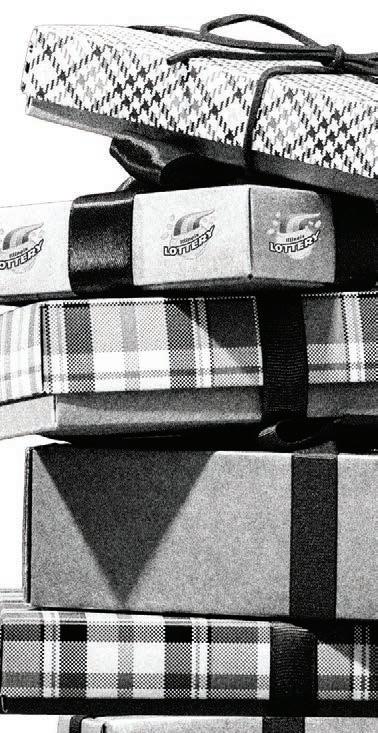







use treatment, mental health care, and case management services for people awaiting trial.
When coalition members would speak with press or host public education events, they made sure “our messaging was in line with each other,” McLoughlin says. “When people were having meetings with stakeholders, we were again adhering to these principles that maybe weren’t the dream vision that any of these organizations had, but they were a consensus that we could all feel good about working together on. . . . That has served as a foundation for all of our work over what is now nearly a decade.”
It’s that meeting in the middle, that support across neighborhoods, that builds the momentum needed to reach solutions that serve us all: whether we’re baristas or mothers in Chicago or Palestine, working-class people in white neighborhoods or Black neighborhoods; in the suburbs or in the city.
Ramsey says she dreams of education for everyone, where every person has access to housing and health care. In a city separated by transit routes that reinforce racial inequities, where some segregated Black neighborhoods cry out against South American migrants, where south- and west-side schools scramble to teach with a fraction of the resources held by north-side facilities, organizers have a decades-old playbook for subduing those forces.
“For us to get to that point, we have to be able to cross boundaries and build a strong coalition, build a strong movement, that has a shared vision and is willing to speak with one another and educate our di erent communities to grow that shared vision,” Ramsey says. v
m dmbrown@chicagoreader.com

This story was copublished with the Trace, a nonprofit newsroom covering gun violence in America.
As Chicago’s ShotSpotter microphones come down following years of controversy about the gunshot detection device, the Chicago Transit Authority (CTA) is trying out a new tool designed to detect the presence of firearms—this time, through video surveillance.
Through a $200,000 pilot, the CTA is adding ZeroEyes to its security measures. ZeroEyes is a software application that uses artificial intelligence (AI) and human analysis to scan surveillance footage and alert police to the presence of guns. Though the Philadelphia area–based company tried and failed to launch in its hometown, the CTA is still eager to test out the technology, saying its cameras are better equipped to handle it.
But in the aftermath of ShotSpotter, the CTA’s ZeroEyes pilot is raising similar concerns about the e ectiveness and ethics of using surveillance to try to stem shootings.
“We have a record now of more than two decades where we have been promised that these types of technologies will make us more safe,” said ACLU Illinois spokesperson Ed Yohnka. “Chicago is one of the most surveilled cities in the world and we’re still plagued by a high level of gun violence.”

ZeroEyes proponents say it will improve public safety by helping police respond faster to potential gun threats. But there have been at least a few instances in and out of Chicago when ZeroEyes flagged objects that weren’t firearms, raising questions about causing unnecessary police interactions.
Cofounder Sam Alaimo said that ZeroEyes does everything it can to prevent false alarms. The company did not respond to questions about its success rate or how many guns the team has intercepted. As for how Chicago police decide to respond to their alerts, Alaimo said that’s ultimately “not our business.”
“We’re not handling police response,” Alaimo said. “We just give them the evidence.”
Violent crime has been growing on Chicago’s public transportation system since 2002,
As Chicago ditches ShotSpotter, a new gun detection technology raises similar concerns.
By JUSTIN AGRELO, THE TRACE
peaking in 2021 at 4.2 violent crimes per 1 million rides, according to an analysis of police and CTA data by WBEZ.
The CTA is running ZeroEyes on “roughly 250” of its more than 33,000 surveillance cameras, CTA spokesperson Manny Gonzales wrote in an email to the Trace. CTA officials didn’t say which train platforms have ZeroEyes devices, citing security concerns, but said they used criteria like ridership trends
on the Blue Line, have sparked calls for more security, Lance Williams, a professor of urban community studies at Northeastern Illinois University, sees the ZeroEyes launch more as a public relations strategy than a public safety investment. Williams has spent more than two decades studying gun violence. He said the ZeroEyes partnership is the city’s latest e ort to appear to be tackling gun violence without addressing its root causes.
“To even place so much emphasis and resources into surveillance—and even law enforcement to a large degree—is almost wasted money,” Williams said, because these tools work “always after the fact.”
ZeroEyes was founded in 2018 in the Philadelphia suburbs by a group of former Navy Seals and Special Operations veterans concerned about mass shootings. The company connects AI-powered software to cameras in places like schools, businesses, and public transit. As previously reported by the Trace, ZeroEyes was set to launch on Philadelphia’s public transit system in 2023, but that partnership was quietly shuttered when the software was found to be incompatible with the system’s cameras. The company markets itself as a “proactive tool” that keeps people safe by alerting police or other emergency responders within three to five seconds after a gun is spotted. Human analysts help confirm that the objects the computer catches are indeed firearms.
and crime data to select them. When an object believed to be a gun is spotted on a platform, ZeroEyes alerts the CTA, the O ce of Emergency Management and Communications, and police. The CTA pilot comes in addition to an existing ZeroEyes contract at Navy Pier.
“This ZeroEyes pilot is just an added layer of security,” Gonzales said.
While several recent shootings on CTA property, including a quadruple homicide
During a recent Zoom conversation, Alaimo played footage of ZeroEyes in action. One clip showed a man pointing a gun on a train platform. Police arrived with their weapons drawn and arrested him. Another showed several young people carrying what Alaimo said were several AK-47s at the entrance of a school.
A recent report from Block Club Chicago said the pilot was “shrouded in secrecy.” Block Club noted that the CTA did not hold a competitive bidding process for the pilot, and Chicagoans never had the opportunity to weigh in. Alaimo said the United Safety and Surviv-
ability Corporation, a company that designs and manufactures products for public transit systems, connected ZeroEyes to the CTA. According to Gonzales, the agency became aware of ZeroEyes after other transit agencies piloted the program.
“Most clients don’t want us talking about their relationship with us,” Alaimo said. “They don’t want people to think there’s a gun problem.”
Yohnka said the CTA’s decision to launch ZeroEyes without community feedback fits into a larger pattern where city leaders “just announce” surveillance technology without inviting residents to speak up.
The decision to partner with ZeroEyes reflects the disconnect between CTA leadership and commuters, said Jose Manuel Almanza, director of advocacy and movement building for Equiticity, a transportation justice nonprofit. Almanza, who was involved in the Stop ShotSpotter campaign, said that for the riders Equiticity works with, inconsistent service, poorly lit stops, and mental health crises are more pressing safety issues.
ZeroEyes has flagged objects that aren’t guns to law enforcement. In Texas, both the AI and human analysts mistook a shadow for a firearm, causing a school to lock down. Earlier this year, Navy Pier security dispatched an armed response after the AI and analysts misidentified a toy gun to be used in a play.
Critics, Alaimo said, focus on the Texas incident but not the “hundreds of actual detections” from ZeroEyes. “We dispatched that under full awareness that it looked exactly like a gun to err on the side of safety,” he said, because if it had been a gun, “the damage would have been far more catastrophic.”
In the aftermath of ShotSpotter, the CTA’s ZeroEyes pilot is raising similar concerns about the effectiveness and ethics of using surveillance to try to stem shootings.
“People are tired of the same old solutions when it comes to public safety,” Almanza said. “If there was more community involvement in these kinds of decisions, CTA leaders would know this.”
Alaimo’s comments echo a common refrain of ShotSpotter supporters: If the technology saves one life then it’s worth the investment.
False positives, though, can be dangerous, Yohnka said, especially as some seek to minimize unnecessary interactions between police and residents.
But Williams’s concerns run deeper. These companies get “multimillion dollar contracts to profit o Black and Brown misery and trauma,” he said. “The city has created the stress and then they allow white-owned companies to profit from the stress they created. Why not put those resources in the hands of the people who are traumatized?” v
m letters@chicagoreader.com

God forbid we change For everything must remain As it always was
We need the same friends To never leave our sides Gossiping like simpler times
At the seafood sports grill on the water Where the Eagles cover band Plays and plays
Move away or stay?
New beginnings or old ways? Every choice is wrong
What happened to our home?
Another church is closing Farewell house of God
What happened to our cafe?
Trap music and a remodel
Dressed in white; fresh fade
High rises; new folks Messi penalty kicks at the airport Great bogeymen of our day
The place we once knew Is still as it was Our pockets are just thinner
Above us they strive
By Casey Cereceda
To make each city like the next
We blame neighbors
Who don’t stay long
We miss old buildings
Though all is not lost
We carry culture
Fresh morning light
Glaring through the window
Golden rays searing against an old cracked wall
A white hot backdrop
For a shadowed silhouette
Rising from slumber
Crossing the room
To switch on the radio
FM static over cars whirring by
A splash of espresso over sugar
Beaten with a spoon
A blue flame ignites my day
I bring home with me
Into this new life
As we always have
As it always was
Casey Cereceda is an educator and musician living in Chicago, IL. Originally from South Florida, he finds inspiration from his childhood. A recurring theme in his work is identity, and how his has been shaped by places of origin and formative experiences related to ethnicity, masculinity, and spirituality.
A weekly series curated by the Chicago Reader and sponsored by the Poetry Foundation.
Fall Hours
Wednesday, Friday, Saturday: 11:00 AM–5:00 PM Thursday: 11:00 AM–6:00 PM
More Light! Exhibition Opening
Join us for a talk with Aram Saroyan and Luftwerk Studio principals Petra Bachmaier and Sean Gallero to celebrate the opening of the exhibition More Light!, which transforms the Poetry Foundation into a dynamic lightbox. October 17, 2024 at 6 PM
Good Dress Book Launch
Join us for a poetry reading featuring Good Dress author and VS podcast co-host Brittany Rogers, followed by a conversation with Kush Thompson. November 2, 2024 at 2 PM
Learn more at PoetryFoundation.org



People who’ve completed their prison sentences can vote in Illinois. But the 28,000 people incarcerated across the state are barred from casting ballots.
By KATIE SCHULDER-BATTIS
The impact of incarceration can be calculated in lost years of freedom, time spent away from loved ones, and missed opportunities to earn degrees and build careers. But prisons in Illinois and across the country have another hidden cost that impacts all of society: lost votes. This year, more than 28,000 Illinoisans will be barred from casting a ballot in November’s presidential election due to state voter disenfranchisement laws.
The 15th and 19th Amendments ban voter discrimination based on race and sex, but laws protecting the right to vote for people impacted by the legal system vary by state. Some have laws protecting the right to vote
for incarcerated people—like Vermont and Maine—while other states limit individuals with criminal records or fully exclude those with felony records—including Virginia and Mississippi.
Illinois is one of 23 states that deprive people of voting in elections while they are incarcerated in prisons, reentry centers, or transitional living homes. People on furlough—temporary release that allows people to leave prison before their sentence ends—or on work release—which allows people to work outside of the prison—are also barred from voting. People who have been released and are completing probation or parole can vote.
In Illinois, the average prison sentence is roughly 18 years, according to a John Howard Association study. That adds up to missed opportunities to vote in four presidential elections.
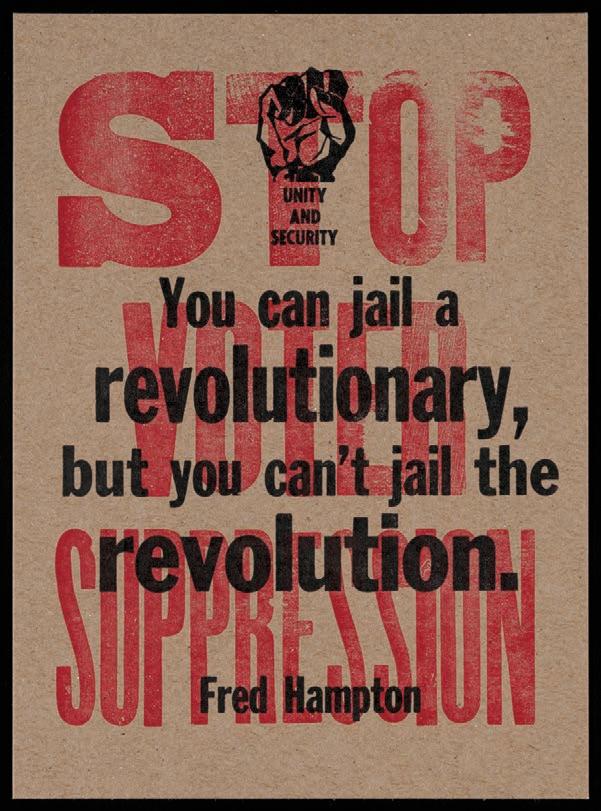
laws vary by state
More than 28,000 people in Illinois Department of Corrections (IDOC) custody will be unable to participate in November’s election. Voter disenfranchisement laws have a sizable impact: in 2020, an estimated 5.2 million people were barred from voting due to convictions, according to research from the Sentencing Project.
The reach of disenfranchisement laws extends beyond those directly affected, according to Nicole Porter, senior director of advocacy for the Sentencing Project, a research and policy center focused on criminal justice reform based in Washington, D.C.
And with over 50 jurisdictions in the country governing voting laws, misinformation is rampant. “There is confusion because there has been reform over nearly a 30-year period where lots have changed,” Porter says.
Since 1997, at least 26 states have enacted policies to restore voting rights for people with felony convictions, which has given two million people the right to vote. Still, information about changes in legislation is not always widely available to people in prison. “There might not be education in some states, and the lack of awareness means that people are subjected to de facto disenfranchisement—they don’t vote because they don’t know,” Porter says.
“A lot of people think that you can’t vote if you have a conviction, but you can,” says Michaela Panzica, currently incarcerated at Logan Correctional Center, a women’s correctional facility in Lincoln, Illinois. “I’ve always wanted to actively vote. But for the majority of my life that I’ve been allowed to vote, I’ve been in IDOC.”
instead of just going down the line and voting Democrat or Republican.” According to Davis, many of the participants in his peer education groups were surprised to learn they could vote once they’re released.
In Illinois, the right to vote in elections is restored immediately upon release—but registration is still required to cast a ballot. Some states, including California, have policies that require prison staff to provide voter registration information to individuals returning home. In Illinois, some IDOC facilities offer civic engagement courses that provide essential—and new—information to people who might’ve never voted before.
But when Davis was transferred to East Moline from Big Muddy River Correctional Center in southern Illinois and hoped to continue to work as a peer educator, his new facility lacked the same programming opportunities.
“People who are disenfranchised are left out of the conversation.”
Panzica, 33, has been incarcerated since she was 17 years old and has a year left before her expected release date. Like Panzica, many individuals in IDOC facilities have been incarcerated since before they could vote. In state prisons around the country, more than one in three people were first arrested when they were 15 years old or younger.
DeAndre Davis, who is currently imprisoned at East Moline Correctional Center, a minimum-security men’s prison in western Illinois, was first arrested at 17. “Coming up in my community, voting wasn’t really big on the priority list,” Davis says.
While incarcerated, Davis earned a GED and an associate’s degree, and he became increasingly passionate about civic engagement and education while working as a peer educator. While leading discussions about civic engagement, Davis emphasized the importance of participating in local elections—not just national politics.
“That’s the thing—just really being informed,” Davis says. “You want to pay attention to the judges, the state [representatives],
Toussaint Daniels began working as a civic instructor while incarcerated at Dixon and Robinson Correctional Centers, two IDOC facilities. Since his release, Daniels has been working fulltime as a certified civic instructor, visiting schools and community centers to engage and educate community members.
“I’m here to show people how important it is to vote, and to give proper context on how their lifeblood is in their vote,” Daniels says.
“We’ve got to be a part of the democratic experience.” Toussaint has been released to a transitional living center, but he is currently still considered an “individual in custody,” meaning he can’t vote. He hopes to be discharged in November before the election.
Voter disenfranchisement can have lifetime collateral consequences for people who have been incarcerated, even when their right to vote has been restored, according to the Sentencing Project’s Porter.
“The general assumption that people with felonies can’t vote undermines campaigns. It’s a huge blind spot for campaigns and policymakers—to create intentional e ort to target marginalized communities,” Porter says. “People who are disenfranchised are left out of the conversation.”
According to Porter, the perception that people with prior convictions can’t vote creates a disincentive for politicians to create platforms that appeal to people in prison and people with convictions. This leads to the creation of policies skewed against people in the justice system—like harsh sentencing laws and policies that impede progress in criminal legal reform.
“We’re in distress—we don’t have a voice and nobody’s trying to hear us,” says Davis, pointing out that even progressive candidates often fail to fulfill commitments to reform while campaigning. “When the cops were killing Black people, there was all of this attention on prison reform. Biden ran on prison reform, and then once he got in, it feels like they forgot about it.”
Biden pledged to create sweeping reforms, including abolishing the death penalty and increasing clemency. Critics have pointed out that the number of people who have been executed each year in the U.S. has increased since Biden took o ce. Since 2021, Biden has granted only 25 executive clemency pardons out of more than 25,000 requests.
By excluding people in prisons from vot-
ing, policymakers are further marginalizing people in prisons, according to Davis, denying people inside the opportunity to voice their concerns about treatment and conditions that they’re experiencing. “If you give us those rights to vote, now you can’t look us over.”
Rat Guereca, also at East Moline, says that being deprived of the ability to vote in elections that will impact his life feels like a second sentence. “The outcome of this election is going to affect us all,” says Guereca. “Unfortunately, as a prisoner, my voice has been stripped. It feels like double jeopardy.”
The benefits of restoring voting rights to people impacted by the criminal justice system extend beyond shaping policy and holding elected o cials accountable. A 2023 study on reentry for returning citizens found people who participated in elections felt more connected to their communities.
“If people vote, they’re involved in their community—they’re part of the community conversation,” Porter says. “Civic engagement is also about community safety.” v
m letters@chicagoreader.com






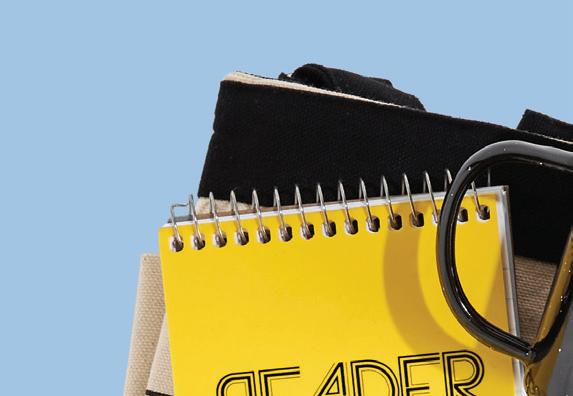



























RTHE MOURNER’S BESTIARY by Eiren Caffall
Row House Publishing, hardcover, 294 pp., $27.99, simonandschuster.com
In her debut memoir, the author associates denial of disease with denial of climate collapse.
By ANCA L. SZILÁGYI
The Mourner’s Bestiary , the debut memoir of Chicago-based author and musician Eiren Ca all, weaves a complex tapestry. It details Caffall’s harrowing experience with polycystic kidney disease (PKD), environmental collapse in the Gulf of Maine and Long Island Sound (landscapes from her childhood), and parenting as a single mom of a child who may or may not inherit her devastating disease, (which has stricken her family for over 150 years). Her prose is as urgent and gorgeous as her ambient folk music.
Anca L. Szilágyi: You worked on the book for a long time, which makes sense given the complexity of the story. The opening, set in Maine’s Monhegan Island in 2014, was already a research trip you’d planned to take with your son When did you begin writing this book?
Eiren Caffall: The idea began with a monthly blog I wrote for Tikkun about nature and god. They gave me lots of freedom to define what that meant. This was 2010, 2011. The column wrestled with climate grief and parenting. My kid was five or six when I started. Many of the themes of this book were present in that writing. I was working out my own feelings about ecosystemic collapse and how to survive it—spiritually, emotionally, physically. I wrote about animals a lot, no surprise since my special interest is animals. I began thinking about bestiaries. That form, spiritual books that rely on people’s obsession with animals and natural history, obsessed me. While I wrote columns about bats and frogs and Monhegan’s warming ocean, I came up with the title and held onto it like a talisman for a decade while I figured out what the book would be. It took me a long time to add the illness component into the story because I’d rarely been public about it fully. My family lived in a lot of shame and fear about disclosing the disease—I absorbed that. A lot of life had to happen while I figured out that it would be important for readers to understand my
own vulnerability as I talked about vulnerable places and nonhumans. It took me a long time to realize that, as my husband says, I was the argument.
I was moved by this notion of using the body “as an instrument of good until I couldn’t use it anymore,” a decision in the wake of your diagnosis with PKD to forgo “a safe future” and dive into life as a musician in Chicago. Can you say more about the choice to embrace music?
My father was a maker of Shaker furniture, and he quoted this Shaker maxim to me grow-
R EIREN CAFFALL BOOK RELEASE
Thu 10/17, 7 PM, Women & Children First, 5233 N.Clark, womenandchildrenfirst.com/event/person-mourners-bestiaryeiren-caffall, free, registration required
insurance and some protections for a person with an incurable disease. Following the least safe path, making independent music without a net, leaned into that streak that said, “You can’t take my joy from me.” It was all risk. It leaned into the hope that I would be able to have the big creative life I wanted, even if I had to live with a deadly illness. I went for four years without health insurance because at the time there were no protections for people with preexisting conditions. I extended my childhood poverty into my 20s. At times, it was scary. But there was nothing as thrilling as writing a new song, performing it here in Chicago, going to see bands that no one had heard of yet who were illuminated with genius.

There are so many sites of ecological wonder! My family and I hike every weekend throughout a three-hours-drive radius of preserved landscapes, wolf oaks and savannas, prairies and glacial landforms, sand dunes and great lakes, ravines and wetlands and remnant forests. In the city, my favorite is the Magic Hedge, or the Montrose Point Bird Sanctuary. It’s a fantastic place to catch migrating birds, full of birders who will point out new species to novices. It’s accessible and paved, so there’s no barrier to entry for users of mobility devices, but has unpaved trails as well that make you feel lost in the prairie. The views of the skyline are incredible. It’s a good place to see piping plovers during the summer.

ing up, “Hands to work and hearts to God.” He looked at his vocation, and his creativity, as a required o ering to the world, a way to be of use. My family was surrounded by creative people. Before my diagnosis I imagined joining them. I’d wanted to be a writer or a singer since I understood that people made books and music. There’s a streak of rebellion in me, a response to being told that I can’t do something that usually looks like, “watch me.” When I was diagnosed, the sensible thing would have been to double down on my studies and pursue steady work—something with
Though the book focuses on the Gulf of Maine and the Long Island Sound, Chicago recurs as a site of chosen community; there’s a beautiful scene of your wedding with Andy, a warm yellow light in a loft full of people giving toasts, sharing poems, and singing songs, snow falling outside. There’s also a lovely scene of you and your son on Hartigan Beach by Loyola University, looking for animal bones while foxes watch in the tall grasses. Can you recommend sites of ecological wonder in Chicago?
The first time I drove into Chicago in the 90s, I felt like I’d come home. No matter how much I crave and adore my time on the Atlantic, I come back here with so much joy. I’ve built a family and community of artists here, some of whom I’ve worked with for three decades. I continue to find it generous and kind, experimental and brave, and working-class. If you make art here, you are likely to make it for life, not because you expect fame or money, but because you wouldn’t recognize your life without it.
A powerful thread throughout the book associates denial of disease and denial of climate collapse. I’d like to connect that to the call to readers to create their own bestiaries. What do you hope readers will get out of taking that proactive step?
I’m asking people to make their own list of sacred animals that mean everything to them, that have shaped their personal narratives. We all have them. Maybe your dead father comes back to you as a crane. Maybe every time you spot a monarch, you remember the project you did with your daughter, raising them when she was eight. Animals are often our touchstones to the larger world, the thing that crosses the artificial barriers we pretend exist between us and nature. Those things are a great entry point into activism, conservation, care, and eventually healing. It took lots of people to save the ecosystem where I grew up in the summers, the Long Island Sound, people who cared about getting to go clamming or swimming, people who wanted to see whales come back, or lobsters or seals. Every summer I see the monitors on the beaches at the Magic Hedge protecting the piping plovers. Those people added those birds to their bestiaries and now they’ve chosen work that protects them. It’s a truism I’ve found to be deeply true—you can’t love something you don’t know, and you won’t save something you don’t love. v
m letters@chicagoreader.com






















R“ESCAPING THE TYRANNY OF MEANING” Through 10/26 : Tue–Sat 11 AM– 6 PM, Mariane Ibrahim, 437 N. Paulina, marianeibrahim.com/exhibitions

In his paintings, Leasho Johnson investigates Blackness, queerness, and Caribbeanness.
By JORDAN BARRANT
In Leasho Johnson’s The Sea Is Another Country, a figure is hunched over, mired in a collage of color and fluid shapes. In the painting, birthed in conversation with Dionne Brand’s book A Map to the Door of No Return: Notes to Belonging, this figure is placed in the midst of a Black oceanic landscape. Brand’s text speaks to the rupture that occurred when Africans were brought to North America; reflecting on her own experience growing up in the Caribbean, Brand understands the sea as a carrier of the traumas endured by enslaved Africans. Turning to this text in The Sea Is Another Country and throughout his exhibition “Escaping the Tyranny of Meaning,” Johnson builds upon years of work investigating Blackness, queerness, and Caribbeanness, and their mythologized aspects as a source of both tension and potential.
The painting is on view at Mariane Ibrahim in Johnson’s first solo show with the gallery. Nine paintings are mounted, each aligned with a style that Johnson continues to develop: constellations of contours and textured Blackness on paper. His abstracted and amorphous figures entangle themselves
in lush landscapes. The title of the exhibition, “Escaping the Tyranny of Meaning”—taken from a William Kentridge essay—speaks to the tension of the way Jamaica’s perception as a tourist destination places locals in a landscape imbued with paradisiacal connotations. Johnson considers how meaning can become a trap and invites others to release themselves from those structures as well.
Growing up in Jamaica, a country dominated by the Protestant religion, for Johnson, queerness was often relegated to the corners. The Centipede Under Two Skies (Anansi #27) is a scene from a bush party, where queer men in Jamaica were able to commune. Charcoal-painted limbs float around a sequence of classroom chairs, representing a memory Johnson has been processing. Coming of age in the shadows of Jamaica coalesces here; walking through the exhibition with Johnson, he said the painting is “moving from a space of clarity and visibility into a kind of darkness, into a kind of wilderness.” Figures emerge as possibly human, possibly animal—an abstracted form where Johnson has historically situated many of his figures. For Johnson,
creatures like Anansi, a trickster spider from West African folklore, begin to harbor ideas of queerness and wildness.
Johnson’s interest in Anansi stories deepened when he arrived in Chicago to pursue graduate studies at the School of the Art Institute of Chicago. He told himself he would either chase the “white rabbit,” an ode to Alice in Wonderland and a metaphor for the kinds of white hegemonies pushed for Black artists to align with, or chase the “black spider,” Anansi, honoring an obscured narrative from the African diaspora—stories his uncle told him
He feels chosen by Chicago—by his community here and the resources he’s had access to.
as a child. In the Anansi stories, the trickster is creating and re-creating himself depending on his circumstances, like queer people. These stories not only invite imagination but require it. In this space, Johnson found room for
abstraction, for the kind of wilderness he explores in his paintings. These spaces become nonspaces and the people become nonhuman. Johnson renders these creatures—who often emerge only at night—through materials that engage with Jamaica’s history of enslavement. His works merge natural materials like charcoal, indigo, and logwood dye with oil paint and gold flakes. Logwood dye was once exported from Jamaica before sugar became its dominant industry. Logwood is the first stable black dye, historically used by the Spanish elite to render blackness. However, when mixed with other substances, it becomes unstable and, in certain conditions and lighting, can appear blue, red, or brown. Johnson considers it a “magic material,” allowing it to present itself differently as it interacts with his other materials. In those moments when black becomes diluted, it emerges as a new color and new line of inquiry.
Like a Deep Breath Held and Held is the most visually intimate of the works. Two figures are intertwined, floating above a fragmented sea. Situated in a room with Set Adrift, Aimless, Hopeless and Destructive , the room is framed by these oceanic respites. Johnson came out as gay beside the water, noting how being beside the water, one becomes more aware of oneself. He now lives by the water in Chicago, a new home for him.
Swimming in the Caribbean Sea, the salt water carries you; in Chicago, the fresh water makes swimming more difficult. The lakes here are marked by a filtration system—controlled bodies of water, a complete contrast to the wildness of the ocean by Jamaica. In the wake of ongoing natural disasters that have impacted the Caribbean for years, the sea’s wilderness and its absorption of environmental disasters loom large in Johnson’s works.
“We think about impermanence a lot in the Caribbean,” he said, noting that there, people have a different relationship to the water. Though he resisted calling Chicago his home for a long time, he’s not fighting it anymore. He feels chosen by Chicago—by his community here and the resources he’s had access to. Though Lake Michigan doesn’t hold the same vastness and obscurity as the Caribbean Sea, Chicago’s water, especially at night, holds its own crawling nightlife—its own kind of wildness. v
m letters@chicagoreader.com















An open-hearted, “utterly absorbing, very funny, darn near perfect play” (The Daily Beast) about leaving your comfort zone to find fulfillment.
Meet Kenneth, a 38-year-old longtime bookstore worker, who is perfectly content with his after-work routine: a mai tai (or two) at the local tiki bar. But when his employer decides to close the store, Kenneth must also turn the page and choose a new direction—including some daring steps into a world he has evaded. BOLD Artistic Producer Malkia Stampley makes her Goodman directing debut with this “tender, delicately detailed portrait” (The New York Times) about new beginnings.
NOW THROUGH NOVEMBER 3
| 312.443.3800 Groups 15+: Groups@GoodmanTheatre.org

A solo show that falls flat Alice Tippit’s latest exhibition lacks selfawareness.
“The Deep Element,” on view at Patron, is Alice Tippit’s second solo presentation with the gallery. Comprised of oil paintings, sculptures, and works on paper, it is a hopelessly pat exhibition.
It’s unclear what Tippit is attempting to accomplish by painting. Quit, with its corpulent limbs, and Bling, with its sliced fruit, manage to make even the most obvious symbols of suggestiveness feel banal, rather than sexy.
Work on paper Out does the not-so-heavy li ing of forging a relationship between the words “count” and “cunt” (hint: they’re only one letter apart). It also dares to posit that font choice impacts how words are interpreted—a point on which, even in these highly divisive times, we all may have already agreed.
The wooden sculptures threaten to be interesting but are thwarted by the inclusion of found objects.
A hummingbird nest (Helm) and scraps of lace (Hull)
“The Deep Element” is simply tiresome. What makes this exhibition particularly disappointing is the fact that Patron generally runs a high-caliber program, with a stable that includes heavy hitters Caroline Kent, Jennie C. Jones, and Bethany Collins, among others. Perhaps when a gallery sets such a high bar for itself, it is occasionally bound to fail to clear it.
—BIANCA BOVA “THE DEEP ELEMENT” Through 11/2: Tue-Sat 11 AM-6 PM, Patron, 1612 W. Chicago, patrongallery.com/ exhibition/505/the-deep-element
Cheri Lee Charlton exposes the devastating consequences of patriarchal misdiagnosis.
Each piece in Cheri Lee Charlton’s solo exhibition, “Unseen and Underserved,” is paired with a quote from literature or professional medical publications about women’s reproductive, general physical, and mental health, exposing misdiagnoses during the late 20th century and its devastating, if not deadly, consequences. In Elliot Valenstein’s psychosurgery chronicle, Great and Desperate Cures, the psychologist writes, “Lobotomies were o en administered to women who were considered too outspoken or too rebellious, reflecting societal norms that prioritized conformity and passivity in women.” The procedure was the standard treatment for psychiatric conditions in the 1950s. Lobotomies were frequently performed on women whose behavior did not meet patriarchal expectations for obedience and submissiveness. During the procedure, a needle penetrates the frontal lobe and isolates the part of the brain that controls emotions, attention, theory-of-mind processing, and complex learning, reducing the patient’s psychological activities through brute force. In one of Charlton’s illustrations, a patient is surrounded by forget-me-nots and Saint John’s wort: flowers for grieving and mourning. A brain sits at the center of the piece. Closer observation reveals the crevasses on the brain to be women figures: do they know they are about to be severed?

indicate that Tippit suffered a crisis of confidence in her own authorship, which would arguably be much stronger if the sculptural forms were allowed to exist unadorned.
Also present is an aqua-colored mural that wraps around the gallery, suggesting a horizon line. It terminates in a cartoonish waveform, just in case viewers didn’t feel sufficiently beaten over the head by the idea that it depicts water.
Buried in cliches with no trace of self-awareness to be found, yet too treacly to be sincere, the work in
Charlton’s art is colorful, intricate, and elegant, similar to illustrations in a vintage fairy-tale collection. Yet the bright colors only amplify the grotesque patriarchal misdiagnoses. As the exhibition notes, if a man said a woman was crazy, his words were as authoritative as a judge’s sentence. Another could determine if and how many children a woman would bear, claiming ownership of her womb. Each illustration shows a woman chained, strangled, muffled, or carved open.
You wonder if they tried to argue, “I’m fine!” If they did, nobody listened. —XIAO DACUNHA “UNSEEN AND UNDERSERVED” Through 11/3: Mon-Fri 9:30 AM-5 PM, Sat-Sun 10 AM-5 PM, International Museum of Surgical Science, 1524 N. DuSable Lake Shore, imss. org, admission $23-$30 v























Colectivo El Pozo brings the story of immigration activist Elvira Arellano to this year’s Destinos festival.
By IRENE HSIAO
On a platform, a scaffold indicating two towers. In one stands a worker, Elvira (Alma Pauleth), looking straight ahead. In another, a dancer (Wannapa Pimtong-Eubanks) feathered in white, a bird or a bride, with an ornate mirror around her neck gleaming like a Catholic medal, who begins to move with fluttering gestures in the area between them, in rows of folding chairs. She leaves the mirror behind.
In the U.S., 47.8 million people, or about 14.3 percent of today’s total population, are immigrants. From 1840 to 1919, around 90 percent of immigrants to the U.S. came from Europe. After changes to immigration law in 1965, roughly half of immigrants came from the same side of the ocean—Latin America—and half of them were from Mexico alone. At present, people born in Mexico are the largest group of immigrants, both with and without documents. About 8.3 million workers, nearly a third of the immigrant workforce, are undocumented.
In August 2006, under threat of deportation by Immigration and Customs Enforcement, undocumented immigrant Elvira Arellano took sanctuary in Adalberto United Methodist Church in Humboldt Park. With a determination that led to recognition as a Time Person of the Year, she remained there for a year, advocating for the rights of the undocumented, before she was arrested and deported for attending a rally in Los Angeles. Cofounder of La Familia Latina Unida (the United Latino Family)—which petitioned Congress to
keep undocumented parents in the States with their U.S.-born children, such as her own son, Saul—Arellano returned to the States in 2014, seeking asylum that has not yet been granted.
In Elvira, written by Raúl Dorantes, directed by Mark Litwicki, and premiered by Colectivo El Pozo at Saint Augustine College’s Charlie Chaplin Hall as part of the seventh Destinos: Chicago International Latino Theater Festival, Arellano’s story begins on an airplane. She is not a passenger, but a worker cheerfully cleaning the aisles between flights, fantasizing about the father of her son, a Christian farmworker in Wapato, Washington, who blames her for the pregnancy. Elvira works weekends, so she hasn’t yet baptized her son—fellow worker and friend Yadira (Mayra I. Echevarría) offers her own church if Methodism is OK. “Dios entiende de estas cosas,” she says (“God understands these things”).
Elvira’s story is told with the simplicity of an allegory.
A small change in denomination is surely less uncanny than a fast friendship between a Mexican and a Puerto Rican brokered through common custodial labor at Chicago O’Hare International Airport.
It’s September 2001, and on the table is the immigration policy that Jorge Castañeda Gutman, Mexican secretary of foreign a airs at the time, calls “the whole enchilada,” which would legalize all unauthorized immigrants from Mexico. It’s September 2001, and airplanes are grounded in the wake of airline hijackings that ignite the explosive collapse of two towers of the World Trade Center in New York. Though the 9/11 hijackers
Through 10/26 : Thu–Fri 7 PM, Sat 3 and 7 PM; Saint Augustine College, Charlie Chaplin Hall, 1345 W. Argyle, clata.org/en/productions/elvira, $25 ($20 students and seniors), presented in Spanish with English subtitles
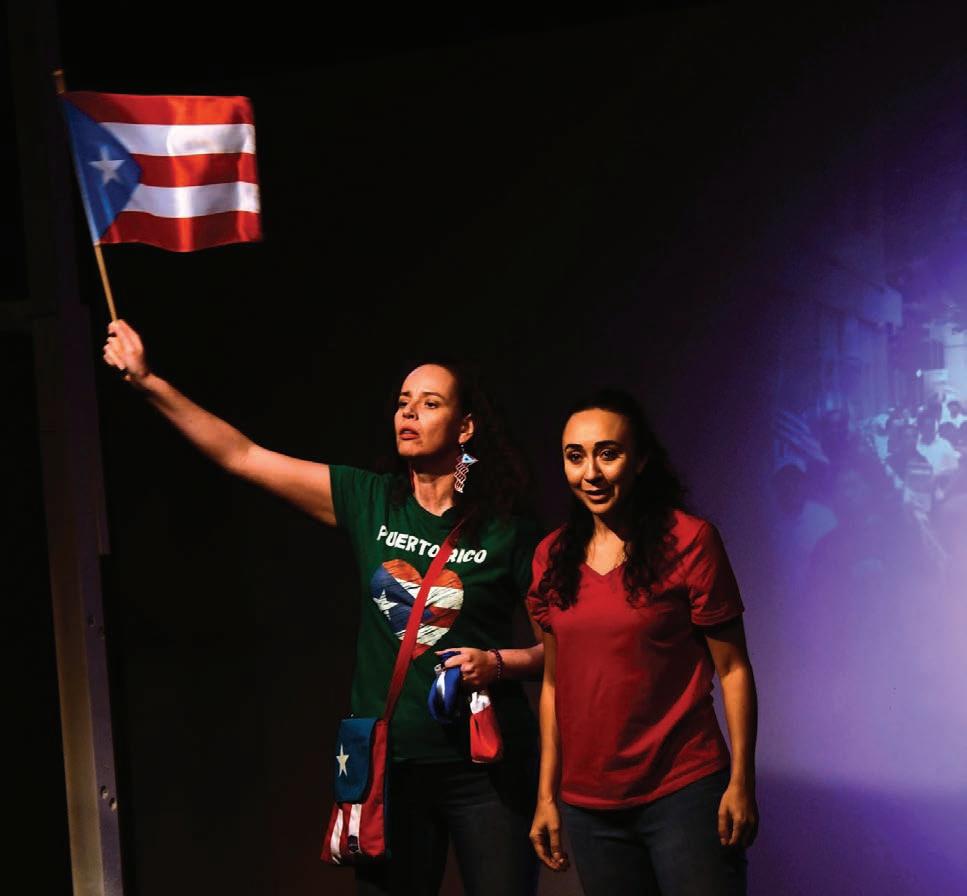
entered the country legally on student, tourist, and business visas, post-terror anxiety led to restrictions on all immigration in the name of national security, as well as general xenophobia toward all those perceived as foreigners.
“No encuentran al Bin Laden, pero me hallaron a mí” (“They didn’t find Bin Laden, but they found me”), says Elvira to Yadira when she’s arrested during a search of O’Hare’s workers. They even took her shoelaces, she laments. Faced with deportation, she chooses the church led by the pastor who founded unauthorized immigrant advocacy group Centro Sin Fronteras (Emma Lozano, not named in the play, played by Aida Palma Carpio). “Have you fed the pilgrims? Have you dressed the poor. Have you helped women in need?” asks the pastor, who declares her church in service of those deemed poor, ugly, and illegal.
As Elvira becomes a face for the 600,000 unauthorized immigrant parents of the three million U.S.-born children like her son, her opponent is embodied in Sistema (Armando Villegas), a white man who spouts anti-immigrant rhetoric (“To me, all of you are Mexicans. And the worst Mexicans are the
Puerto Ricans”), egged on by a reporter (Juanjo López) whose primary function seems to be to stir the pot. But Elvira is adamant about her innocence as a mother and a worker who pays taxes, and her supporters—her pastor, her friend, and the figure of the dancer who leads her into a dance of flight and freedom—are also a vision of female mercy, resistance, and solidarity in a world mismanaged by men.
Elvira’s story is told with the simplicity of an allegory, by a small ensemble that deftly shape-shifts from reporter to legislator to Arellano’s relatives in Mexico. Projections that include footage from the 2009 Javier Solórzano Casarin documentary, Elvira , ground the work in historical images, while original music directed by Juanfra Dimas and dreamlike dance sequences o er glimpses of heart.
On opening night, Arellano appeared with a crimson bird emblazoned on her chest, addressing the audience after the performance. Calm and radiant, she spoke of change, lit from within by possibility. v
m letters@chicagoreader.com
Raven’s Ironbound is a portrait of one immigrant woman’s working-class life.
Raven Theatre is billing its current production of Martyna Majok’s Ironbound as a Chicago premiere, but some theater fans may remember the workshop version produced ten years ago in Steppenwolf Theatre’s First Look Repertory program, starring the indomitable Lusia Strus. Majok did some of her earliest work here a er graduating from the University of Chicago and went on to win the 2018 Pulitzer Prize for Cost of Living
Though Ironbound is set at a bus stop in a desolate postindustrial section of Newark, New Jersey, the story feels right at home again in Chicago under Georgette Verdin’s usual empathetic and pinpoint-precise direction.
Darja (Lucy Carapetyan), who emigrated to the U.S. from Poland as a young woman, works in a paper factory and as a house cleaner (just as Majok’s own mother did). Over several scenes moving back and forth in time at the same bus stop, we see Darja’s fortunes rise and fall (more the latter than the former).
In the first scene, she’s in her late 30s, confronting Tommy (Richie Villafuerte), her mailman live-in boyfriend whose philandering (with one of her wealthy clients, no less) has finally worn her down. “Fourteen times is not mistake,” she tells him a er he grudgingly gives her a number for his instances of inconstancy. “Fourteen times is career!” She may not have a lot of options, but she still has pride. But in late-capitalist America, pride only gets someone like Darja so far. The strength of Majok’s play is that it doesn’t waste time on polemics and instead lets us see the larger social framework of Darja’s life through the snippets of information we glean in these bus stop interludes. Her first husband, Maks (Nate Santana), is a fellow Polish immigrant who harbors dreams of playing blues harmonica in Chicago. Her never-seen second husband is abusive. Her son (also never seen) has drug problems and runs away at one point. A scene with Vic (an endearing Glenn Obrero), a rich private-school kid dabbling in drug dealing who encounters a battered Darja a er she’s run out on husband number two, suggests that the safety net for so many women like Darja comes down to the kindness of strangers, not systems. Carapetyan, who was going to play this role at Steep Theatre in 2020 before the pandemic shutdown, always excels at embodying women who are tough and defiant without ever losing their vulnerability. Darja recalls a friend who lost an arm in an accident at the factory and muses that it happened because “she was thinking of being not here.” Ironbound, like Majok’s Sanctuary City (seen at Steppenwolf last season), roots working-class immigrant narratives in rich and poignant moments in time where people dream of being “not here” while also dealing with grim reality as well as they can. —KERRY REID IRONBOUND
The play’s the thing
El Piélago de las Calamidades imagines Hamlet from the traveling actors’ perspective.
The title of Teatro Tariakuri’s latest, El Piélago de las Calamidades, translates in English as “a sea of calamities.” Alejandro Licona’s comedy takes a page from Tom Stoppard’s Rosencrantz and Guildenstern Are Dead, telling the story of Hamlet through the misadventures of the play’s traveling actors, who are hired by the brooding prince to reenact the story of Claudius murdering Hamlet’s father to claim both the throne and Hamlet’s mother.


Directed by Karla Galván, the show (presented as part of the seventh Destinos: Chicago International Latino Theater Festival) leans into commedia dell’arte performance style and theatrical archetypes. Eugene (Esteban Pantoja, known in the drag community as La Mas Mejor) is the beleaguered company leader with dreams of being a serious playwright. Laura (Nancy Mata) is the sexy ingenue who probably had an affair with the dead founder of the company. Ana (Daniela Aranda) is the resentful not-as-flashy woman who gets stuck with all the shit jobs (when we first see her, she’s hauling the cart with the props). And Henrik (Manuel Duarte) is the scene-stealing diva who carries an oversize skull everywhere he goes. In a curtain speech, Galván noted that the play (like other Tariakuri work) pays homage to the Mexican tradition of carpa (tent theater), which also features traveling bands of artists playing stock characters.
The troupe here are so absorbed in their own squabbles that they fail to recognize that the story Hamlet (Victor Mallari) has given them to perform mirrors what’s happened in the castle. By the time they catch a clue, it’s too late: there are bounties out on their heads, and the last part of the play turns poignant as we see them try (and mostly fail) to escape their fates—just like Shakespeare’s prince. Patricia Galván performs rousing musical numbers before each of the two acts of the show, which by and large balances the bawdy elements with moments of insight into the longing for fame and fortune driving these ridiculous but relatable showfolk.


























Through 10/27: Thu–Sat 7:30 PM, Sun 3 PM; Raven Theatre, 6157 N. Clark, 773-338-2177, raventheatre. com, $45 (student/military/industry $30)
Through 10/27: Sat 7 PM, Sun 5 PM; Teatro Tariakuri, 3117 W. 63rd St., teatrotariakuri.org, $35, 15+, in Spanish with English subtitles v
























A collection of hot nudity and sex scenes lives forever on the Chicagoborn website.
By S. NICOLE LANE
Getting o doesn’t always have to include the first video that pops up on Pornhub. In fact, turning yourself on can be more curated and more refined—and it can include your favorite celebrity tush.
When Mr. Man first went live online ten years ago, the website developers aimed to create a warehouse of archived male celebrity nudity where viewers didn’t have to sit through a flick just to catch a glimpse. What began as an extension of the website Mr. Skin—which archives female nudity in television and film—has resulted in a catalog of more than 11,500 titles, 37,000 male nude scenes, and 14,000 actors from television and the big screen. Viewers can stream, download, and watch their favorite scenes.
While Mr. Man lives online, it also has its roots entrenched in Chicago.
Jim McBride, aka Mr. Skin, is the founder of both Mr. Skin and Mr. Man, and he grew up in River Forest. In 1996, WMVP radio show host Harry Teinowitz approached McBride in a Lincoln Park bar after overhearing McBride tell his friends about his wealth of celebrity nude knowledge. From such a chance encounter, McBride was invited on the radio show as a regular, where he answered questions from eager callers. This eventually allowed him to raise money and launch MrSkin.com in 1999. McBride would go on to be known as the leading expert on celebrity nudity in film, appearing on shows with people like Howard Stern and Mancow.
There are now other Mr. Skin- and Mr. Man-adjacent websites on the Internet. However, Mr. Skin paved the way for documenting celebrity nude scenes, and Mr. Man sat on the shoulders of that concept.
Steve Attanasie, the editorial manager for SK Intertainment, Inc., the parent company of both websites, said that the evolution from Mr. Skin to Mr. Man was natural.
“We’re already dedicated to cataloging
every female nude scene from film and television; why not catalog the male nude scenes while we’re at it?” he says. By the time Mr. Man launched, Mr. Skin had already been around for almost 15 years. “Our systems and processes were perfected to the point that we could take a big risk and step outside our comfort zone.”
There isn’t much crossover between the two websites. There’s a similar aesthetic and website layout, but, Attanasie says, “In a lot of ways, Mr. Man is kind of just the inverse of Mr. Skin.”
Craig is consistently one of the most searched celebrities at Mr. Man.”
While some videos and clips on the website are free, full access requires a $5-per-month membership.
For their ten-year celebration in September, Mr. Man released a list of their top ten favorite nude scenes of all time, featuring media like HBO’s The White Lotus, Gone Girl (2014), and more.
Mr. Man was originally intended for women; the founders were hoping to appease women viewers who had been left out and neglected when it came to watching nude scenes. However, they quickly realized that gay men were the majority of their viewers. Attanasie notes, “Men are big spenders, regardless of sexual orientation.” So they began to see the membership grow toward gay men, who are still their majority audience.



On Mr. Man, playlists of videos entitled, “Straight Men in Gay Roles,” or “Hollywood’s Hung,” ensure that viewers can easily find what will get them hot and ready. Mr. Man unleashes all of the facts about the scenes as well: Is the penis real or a prosthetic? Did he really jerk off? Was that really urine? Moreover, each scene includes a review with a rating for hotness. Viewers can browse the website for celebrities, movies, TV clips, photos, playlists, original videos, and live cams. Viewers can also search categories that match their personal preference like “balls,” “real sex,” “weird and wild,” or “year specific,” where you can find the best blowjobs from the 90s or the best butts from 2022. The website also includes lists, like a ranking of the hottest, most searched celebrities, with Daniel Craig at the top. “Thanks to his large penis and balls, amazing nudity, ripped body, and leading man looks,” says the website write-up, “Daniel
and sexy experience.”
The Mr. Man office was once a brick-andmortar, first in Oak Park and then in Wicker Park. However, since the pandemic, the team has been fully remote.
“It’s wonderful being headquartered in one of the most LGBTQ-friendly cities in the country,” says Attanasie.
And beyond Chicago, in the past ten years, society’s views on nudity and sex have matured and developed. Attanasie says social media plays a huge role in the shift, too.
“While there was this belief that nudity and sex scenes might diminish altogether in the wake of the #MeToo movement, it’s actually quite encouraging to see Hollywood embracing this notion of intimacy coordinators.”
Intimacy coordinators are crew members on the sets of movies, TV shows, plays and musicals, and other productions. They ensure that the actors in sex scenes are being taken care of and feel safe within the scene.



As for the day-to-day at Mr. Man, the archival process is intensive. Daily, the content team of roughly a dozen people looks over film and television content that would apply to Mr. Skin and Mr. Man. From there, the editorial team works on creating biographies, reviews, scene descriptions, blog posts, and video scripts for both websites. “Having a team filled with di ering worldviews gives you the opportunity to consider things you otherwise wouldn’t,” Attanasie explains. “So having a small but very flexible team has allowed us to change with the times, reshape our voice, and provide our readers with a great, fun,
“It helps to give the actors more control over what they do and don’t show, and we think it will ultimately lead to more nudity as the entire process begins to feel safer,” says Attanasie. Attanasie says that the process at Mr. Man involves giving people something unexpected. “We bring people to the site with some buzzy top ten about the ‘most demure nude scenes,’ and then we offer them videos and blog posts and running series they didn’t know they wanted. So we just try to keep ourselves perpetually balanced on that tightrope,” he explains.
As for the next ten years, Attanasie says they plan to continue to o er the same high-quality content. “We’re always open to whatever our readers want to see. Whether they tell us by writing in or through their clicks, we’re always listening.”
So, the next time you want to watch the infamous final scene in Saltburn, you can visit Mr. Man and fast-forward, pause, and rewind to see as much Barry Keoghan as possible. v
m letters@chicagoreader.com





Iwouldn’t say the films of Michael Powell and Emeric Pressburger, who referred to themselves collectively as the Archers, are a blind spot of mine, but I’ve seen their films piecemeal over the years and hadn’t thought too much about them from a critical standpoint. Cinema Unbound: The Creative Worlds of Powell and Pressburger, ongoing at the Gene Siskel Film Center through October 17, is rectifying that, fully immersing me into the filmic capriccio of this duo’s vision.
A double feature of Black Narcissus (1947) and The Red Shoes (1948) on the big screen was an illuminating introduction to this particular deep dive. I had the good fortune of seeing Black Narcissus close out the Nitrate Picture Show a while back, but it was rewarding to see it again in the context of a Powell and Pressburger retrospective. Martin Scorsese—a great admirer of the Archers who has been instrumental in the restoration of their films—once said that it’s “one of the earliest erotic films,” as it centers around a group of Anglican nuns sent to the Himalayas and the tense relationship between two of them and the dashing Mr. Dean (who was way ahead of the recent trend of slutty short shorts for men).
“It is all done by suggestion,” wrote Powell, “but eroticism is in every frame and image from beginning to end. It is a film full of wonderful performances and passion just below the surface, which finally, at the end of the film, erupts.” Its lush Technicolor mien undergirds the latent eroticism, the colors burning where desire, outward, cannot. The film was shot by British cinematographer Jack Cardi , who also shot The Red Shoes , perhaps the duo’s most acclaimed film. Scorsese goes so far as to say The Red Shoes is in

his DNA, something Thelma Schoonmaker, Scorsese’s longtime editor and Powell’s widow, told an enthusiastic audience at the Film Center on Saturday when she appeared in person to introduce the film and participate in a discussion afterward.
The pièce de résistance of the film is a 12minute sequence wherein the titular ballet is performed. It is among the most stunning stretches of celluloid ever projected onto the big screen (in this case on DCP); in it, cinema seems the most total of art forms, as it can encompass all of them, more than just giving life to ideas but committing them to posterity so that they live on even as those who created them pass on.
I had the opportunity to interview Schoonmaker before the screening. Between this and hearing her speak afterward, I learned a lot about three titans of cinema: her, Scorsese, and, of course, Powell. Schoonmaker kept saying that she has the best job, having worked with Scorsese for more than 50 years, beginning with Who’s That Knocking at My Door (1967), which screened at the Film Center several weeks ago. It would seem they share with Powell not just their own distinct artistic visions but also a reverence for creation in and of itself. “For ten years we had all been told to go out and die for freedom and democracy; but now the war was over,” Powell wrote in his 1986 memoir, A Life in Movies. “The Red Shoes told us to go out and die for art.”
A good note to end on. Until next time, moviegoers. —KAT SACHS v
The Moviegoer is the diary of a local film bu , collecting the best of what Chicago’s independent and underground film scene has to o er.






Photos from the fest’s 18th year demonstrate the indomitable spirit that’s carried this free celebration of musical community through climbing expenses and declining funding.
By MICHAEL JACKSON
The version of this piece at chicagoreader.com includes dozens of additional photos.
The Hyde Park Jazz Festival, one of the most astutely curated and organized arts events on the Chicago cultural calendar, reached its 18th year the last weekend in September. Except for one brief shower, the rain in the forecast stayed away, and though the Hyde Park Herald had just published a story on the financial headwinds faced by the festival—even suggesting that this could be its final year—neither that news nor the thick gray clouds could dampen the mood. The fest’s usual broadly diverse audience—one of the best features of this south-side jewel—showed up and remained attentive and engaged for all the music on the program, no matter where it landed on the Venn diagram of “challenging,” “educational,” and “fun.”
In the Logan Center Performance Penthouse on Saturday, you could hear the proverbial pin drop during the molecular-level investigations and minutely wound simpatico melodies of saxist-flutist Anna Webber and protean pianist Matt Mitchell. The same was true later in the day, when the keenly pitched dynamics of Nick Mazzarella’s alto sax synced with Russ Johnson’s disciplined trumpet. Even though the end of one set frequently ran right up to or even overlapped with the beginning of another, few in the audience left till after the final notes.
These rarefied, poised presentations were balanced by such get-across purveyors as Willie Jones III, Justin Dillard’s funky fresh the Wherewithal, and gregarious drummer Charles Heath. Inaugural Chicago poet laureate avery r. young celebrated James Baldwin, and upbeat artists such as Juli Wood and the Brown sisters made great companions to the danceable Latin grooves of the Afro-Caribbean Jazz Collective and Victor Garcia’s octet. If you didn’t study the program ahead of
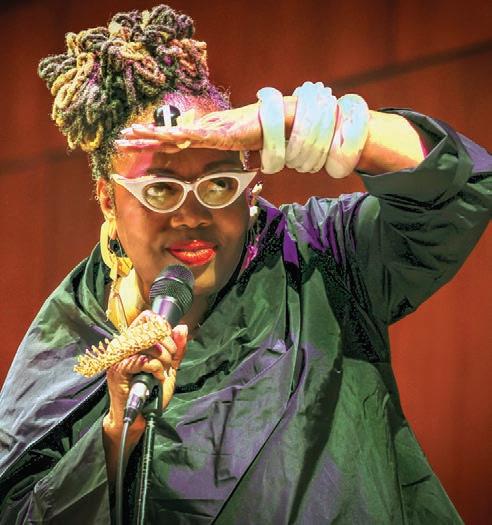

time, you were setting yourself up for some surprises. Though vocalist Dee Alexander is a festival regular, this time she appeared in an unexpected context: as part of a 14-piece Boston-based orchestra celebrating the music of somewhat obscure composer Makanda Ken McIntyre. I interviewed McIntyre for New City decades ago, but since his passing in 2001,


hundreds more of his compositions have come to light, and the Makanda Project performed several of them newly arranged by pianist John Kordalewski.
You might know drummer Nate Smith from his work with bassist Dave Holland (he also cowrote and coproduced Michael Jackson’s 2001 song “Heaven Can Wait”), but would
you have expected a solo set from him in a prime evening spot? And the nonpareil trio of pianist Craig Taborn, cellist Tomeka Reid, and drummer-vibraphonist Ches Smith, a relatively new group, had never performed in Chicago before.
The thought “Steve Reich in a blender” came to my mind while listening to this trium-
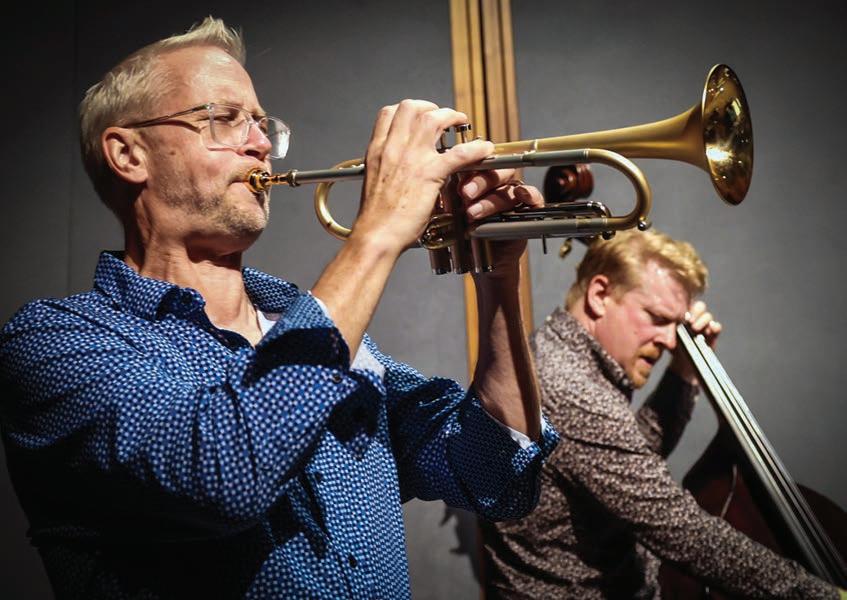

virate. Smith bowed his vibraphone, drawing theremin-style long tones from it; Reid looped percussive plucks and interpolated plosive electronics; Taborn augmented his sometimes exuberant, sometimes placid acoustic piano with synth colors and textures. The sci-fi elements in their set echoed Taborn’s contributions to the Rob Mazurek Exploding Star Orchestra, a cosmic aggregation represented at the festival by the world premiere of a concert film by Brian Ashby that captures their psychedelic Adler Planetarium performance from 2023.
The Hyde Park Jazz Festival inarguably nourishes the local jazz scene, even pushing it in new directions, and you could make a strong case that it does the same for the national and international scenes too. As im-
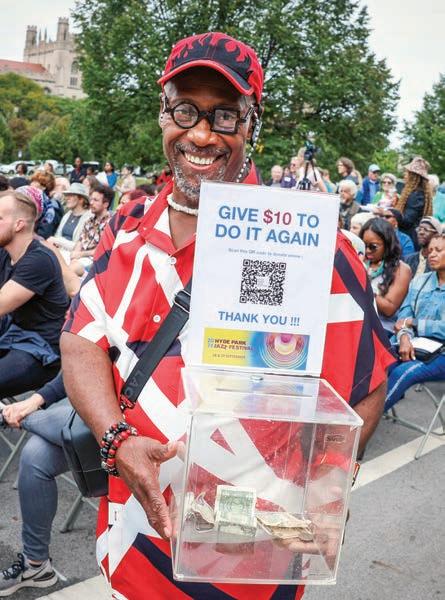
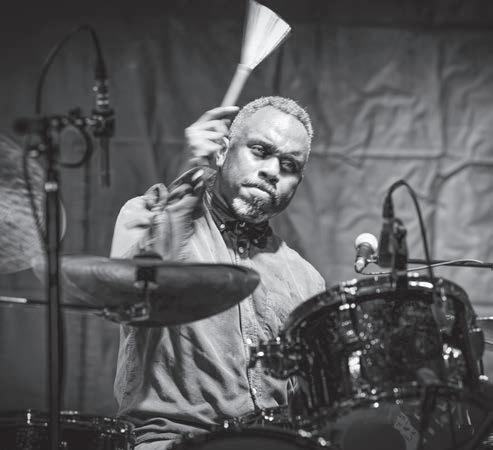


portant as that is, though, it doesn’t directly generate any revenue. How is the festival holding up against the rapidly rising expenses that contributed to the shuttering of the Hyde Park Summer Fest and the Silver Room Block Party? What was that Hyde Park Herald story talking about?
“In 2024, the festival encountered a complex alchemy of post-COVID financial challenges,” says HPJF executive and artistic director Kate Dumbleton, who’s held that position since 2012. “This includes a 90 percent cut in financial support from the O ce of Civic Engagement at the University of Chicago since 2022, in addition to navigating other shifts and cuts in institutional philanthropic giving.”
She puts a number to those rapidly rising expenses too. “These challenges collided with
the 35 to 40 percent post-COVID inflation in the areas of production costs (tables, tents, chairs, security, insurance, fencing, generators, et cetera) to form a perfect storm of rough waters,” she explains.
Dumbleton reminds me that the Hyde Park Jazz Festival is a well-run organization, capable of bracing strategically for punches like these. “There are significant challenges for the future,” she says, “but the HPJF has a demonstrably relevant and vibrant mission, a skilled leadership team, a strong community base of support, and a committed board of directors.”
The festival has cleared big hurdles before— in fall 2020, it coped with COVID by staging pop-up outdoor concerts with mobile stages in flatbed trucks. “We are highly adaptive, as has been proven many times over the years,”
Dumbleton says. “We are hopeful that institutional funders and other donors recognize the significance of a major free platform for jazz on the south side and the ways that HPJF impacts and supports Chicago culture.”
Weather contingencies are part of the festival’s fiscal planning, but even if the uncertain skies impacted attendance on the Midway Plaisance, the indoor venues were often at capacity.
“We are grateful to those who donated or purchased a T-shirt (which sold out) or a beverage. Revenue from donations and purchases helps us meet our budget,” Dumbleton says. “Our 20th anniversary is in 2026, and we are focused on celebrating that milestone.” v
m letters@chicagoreader.com
THE SECRET HISTORY OF CHICAGO MUSIC
A er a brilliant but underappreciated album in 1964, she stepped away from a music industry that treated women badly and mothers worse.
By STEVE KRAKOW
Since 2005 Plastic Crimewave (aka Steve Krakow) has used the Secret History of Chicago Music to shine a light on worthy artists with Chicago ties who’ve been forgotten, underrated, or never noticed in the first place.
Sometimes I have to play the long game to get an artist’s story for the Secret History of Chicago Music. In 2011, when I got the itch to write about generation-bridging folk singer Jo Mapes, I couldn’t find much info— and my attempts to reach her online failed. I shelved the idea.
Last month, I was reminded of Mapes when I stumbled across a rare copy of her 1964 LP And You Were on My Mind at Jerry’s Records in Pittsburgh. After that album, she’d retired from recording and hardly performed publicly. When I looked her up again, I learned that she’d died in 2018. There’s a silver lining, though: her passing inspired people to share what they knew of her amazing life, so that I can finally share that story with you.
Mapes was born Joanne Claire Coombs in Chicago on July 20, 1931, and raised by her maternal grandmother, Rose Shanas. (“Mapes” is her first husband’s last name.) When Mapes was a teenager, they moved to Los Angeles, where she befriended future folk star Odetta at Thomas Starr King Junior High. In the early 50s, Mapes brought her love of traditional song to the stage, playing in local clubs. In 1955 she appeared with her guitar on an LA-based TV talent show called Chance of a Lifetime By the late 50s, the folk boom was in full swing. Mapes hopped around the country, moving to San Francisco in 1957 and then to Chicago. Encouraged by future Bob Dylan manager Albert Grossman, who cofounded
famous Windy City folk club the Gate of Horn in 1956, she took the leap to New York, where she played the crucial Greenwich Village scene.
While still in the Bay Area, Mapes shared a 1957 LP with Rolf Cahn and Carl Granich. Her first album of her own, a self-titled LP under the name Jo March, came out that same year on Kapp Records. She followed it in 1958 with the Kapp release Kisses Sweeter Than Wine

“She was very much an original, and someone who influenced others who came along and did better,” said Old Town School of Folk Music guitar program manager Jimmy Tomasello in Mapes’s Sun-Times obituary. Her early sides reputedly inspired yet another contralto folkie, Mary Travers, who’d briefly roomed with Mapes in New York and in 1961 would become one-third of Peter, Paul & Mary.
In 1962, Mapes taped the pilot for the TV show Hootenanny , which became a huge pop-cultural phenomenon soon after it began airing in ’63. Several of her subsequent albums played on the popularity of the show or simply compiled her TV performances or outtakes. In 1963, Kapp released The Hootenanny Star (and several Hootenanny compilations that included Mapes). That same year, the compilation Hootenanny—Live at the Bitter End came out on the short-lived FM Records, run by Pete Kameron (future cofounder of LA Weekly) and Monte Kay. It features Mapes alongside Bob
Carey, Len Chandler, and Fred Neil.
Like Neil, Mapes bridged the trad-folk old guard and the incoming wave of introspective, melancholic folkies. Hootenanny talent coordinator Fred Weintraub also owned Greenwich Village club the Bitter End, ground zero for this new acoustic movement.
In her ReverbNation profile, Mapes calls the early Kapp material “cutesy peppy folk songs.”
And she has other reasons to resent the Hootenanny records. “I hate them,” she told the Sun-Times in a 1987 interview. “I’m on albums I didn’t even know existed. I was a regular on a show called ‘Hootenanny,’ and, when that became famous, they took outtakes right o the floor and made ‘Hootenanny’ albums.”
Mapes was under a contract that denied her royalties from her performances on Hootenanny. In that same 1987 interview, she claimed she didn’t own the rights to any of her albums—and that she’d turned down what could’ve been a star-making opportunity.
“Jac Holzman of Elektra Records wanted to sign me as their ‘new girl’ singer,” Mapes recalled. “I said I’d sign but only if I could do my material. He said no. Instead, he hired Judy Collins, whose first hit was ‘Someday Soon,’ a song I had taught her. They took my arrangement and everything.”
Despite her troubles with the industry, when Mapes recorded And You Were on My Mind , she created an underappreciated masterpiece. Listening to this fragile but rugged album now drives home just how ahead of the curve it was—it sounds like a template for future stars such as Joni Mitchell and Janis Ian.
Mapes delivers somber, vulnerable covers of songs by Ira Gershwin and Kurt Weill (“My Ship”) and one-man band Jesse Fuller (“San Francisco Bay”), making them entirely her own. The album also includes three Mapes originals: the world-weary and heartfelt “Me and My Friend” and “The Miles Go Past” and the brilliant, mournful “Come On In.” That
tune later got the pop treatment in covers by the Monkees and the Association.
Sadly, few people heard And You Were on My Mind. The album barely got distributed—it was also an FM Records release, and the label went bankrupt and folded within the year.
The last of the Hootenanny compilations on which Mapes involuntarily appeared was the 1964 Kapp release Midnight Hoot, which also includes Miriam Makeba, Alan Lomax, and the Simon Sisters. As far as I can tell, it’s the final entry in her discography.
Why did Mapes leave the music biz? For one thing, by the early 60s she was a single mother, and that made her less likely—and less able—to tolerate its bullshit. “I was the only young woman singer at the time who was supporting three children,” she said. “Judy [Collins] didn’t have children then. [Joan] Baez didn’t have any children. I was trying to combine a career with supporting three kids.”
Mapes left her music career behind with a big send-off concert at Carnegie Hall in the mid1960s. She then settled back in Chicago with banjo player Fleming Brown. They’d married in ’64, making him the next of the four men she’d divorce. Mapes and Brown both taught for years at the fledgling Old Town School of Folk Music.
In 1968, Mapes began a decade-long stint writing criticism, columns, and features for the SunTimes . At the same time, she pursued a career in advertising as a copywriter, producer, voice artist, and jingle writer. She worked for agencies such as J. Walter Thompson and Leo Burnett, whose clients included Kodak, United Airlines, and Kellogg’s (a Raisin Bran campaign paid the bills for years, according to one of her daughters).
Mapes didn’t abandon folk music completely, though. In 1974, she performed at the first National Women’s Music Festival at the University of Illinois Urbana-Champaign. In 1986, she set up the Artists in Evidence performance series in the building where she lived, the Artist in Residence apartments at 6165 N. Winthrop. According to her Sun-Times obit, Mapes played a mid-90s anniversary show for the Old Town School with Bonnie Koloc, Fred
Holstein, and Corky Siegel.
Mapes’s friend Patrick Murfin (who writes a blog he calls Heretic, Rebel, a Thing to Flout) posted a memorial tribute to her. He’d met her in the early 1970s, but he got to know her well only on Facebook in the late 2000s, when she lived in a small apartment in Deerfield. She “was feeling isolated from her friends in Old Town and the Chicago folk scene,” he writes.
“In her 70’s, her health was in decline and her mobility increasingly limited due to failing eyesight.”
Even then, she kept music in her life. Murfin links to recordings that Mapes made by playing guitar on the toilet, which she’d uploaded to ReverbNation.
Murfin says Mapes’s Facebook posts grew more like memoirs, until her macular degeneration got so bad that she couldn’t see well enough to write them. He repeats a story from the 1968 Democratic National Convention about Mapes and her daughters helping protestors flee the cops. “Burly o cers pounded on Jo’s door,” he writes. “She had the girls hide the fugitives in back bedrooms and went to the door in her bathrobe calmly and innocently charming cops into leaving.”
After a long illness, Mapes died at the Brentwood North Healthcare Center in Riverwoods on February 2, 2018. “She was really a pioneer in terms of women folk singers,” said Fred Holstein’s brother Eddie in the Sun-Times obit. “Jo was one of the stars.” Author Shel Silverstein, Mapes’s friend and sometimes babysitter to her kids, called her “the best female folk singer and guitar player around.”
If it were possible to excavate and compile all Mapes’s recollections—and all the stories her colleagues and admirers could tell—they’d surely make the perfect illustration of this folk trailblazer’s importance. But for the time being, I hope my e orts will do. v The radio version of the Secret History of Chicago Music airs on Outside the Loop on WGN Radio 720 AM, Saturdays at 5 AM with host Mike Stephen. Past shows are archived at outsidetheloopradio.com/tag/secrethistory-of-chicago-music.
offer flexible schedules for all skill levels both in-person and
Recommended and notable shows with critics’ insights for the week of October 10

RAVYN LENAE, ARIMA EDERRA Sat 10/12, 8 PM, Vic Theatre, 3145 N. Sheffield, $29-$48. b
CHICAGO R&B SINGER RAVYN LENAE has held me in a trance for close to a decade. She impressed me with the self-released 2015 EP Moonshoes when she was still a teenager, and even in an increasingly unstable music industry, she seemed sure to achieve future success. Her 2022 fulllength debut, Hypnos, broadcast her skills to a much bigger audience, thanks to the backing of Atlantic Records. As dazzling as that record is, I’ve been waiting for Lenae to release the even better album I knew she had in her—an album as forthright and evocative as August’s Bird’s Eye (also on Atlantic). Lenae recruited DJ Dahi—whose CV includes
one of Kendrick Lamar’s best songs, “Money Trees”—as the executive producer of Bird’s Eye, and their collaboration has produced a tighter album that’s more coherent even as it takes bolder stylistic swings. On “Bad Idea,” her light falsetto tiptoes over laser-gun synth runs and a concussive electronic stomp, so that the rangy instrumental gives Lenae repeated energy boosts while casting the Fabergé-egg delicacy of her voice into sharper relief. Throughout the album, she performs with the confidence and command of the biggest stars in the world—and from the sound of Bird’s Eye, she may join them someday soon.
—LEOR GALIL
Somi 7:30 PM, the Promontory, 5311 S. Lake Park Ave. West, $25-$250. 21+
Jazz singer Somi Kakoma is a multihyphenate talent—she’s also a composer, actor, and writer—but she’s best known for her rich, soaring voice. Born in Champaign to parents from Rwanda and Uganda, Somi split her childhood between Zambia and Illinois. Her father worked as a professor at the University of Illinois Urbana-Champaign, where in the early 2000s she earned a degree in cultural anthropology and African studies; she then pursued a master’s in performance at New York University’s Tisch School of the Arts. Her work is informed by her

multinational upbringing and activist spirit, honoring the distinctive traits that make cultures and communities precious while celebrating the universals that connect them—and condemning forces of division such as racism, xenophobia, and misogyny. On her 2014 album The Lagos Music Salon , recorded in Nigeria and New York, Somi combines jazz, pop, and electronic music with Afrobeat and socially conscious lyrics that center the plight and joy of Nigerian women. Her sleek 2017 follow-up, Petite Afrique, tells poignant stories about African immigrants in a gentrified Harlem with an evocative blend of jazz, field recordings, and West African music.
Somi’s latest album, 2022’s Zenzile: The Reimagination of Miriam Makeba , pays tribute to the South African singer and activist by reworking her songs with help from guests such as Gregory Porter, Angelique Kidjo, Seun Kuti, and Ladysmith Black Mambazo. Somi’s years of avid research into Makeba also fed into her debut as a playwright, the 2021 musical Dreaming Zenzile, which takes as its narrative frame the final day of Makeba’s life, between the heart attack she suffered onstage in November 2008 and her death later that night. As Somi told Forbes, the album and stage production are meant to be in conversation with each other and shed light on a groundbreaking figure who has too o en been overlooked, especially in the States—Makeba’s U.S. visa was revoked after she married Black Panther leader Stokely Carmichael in 1968. “It’s interesting
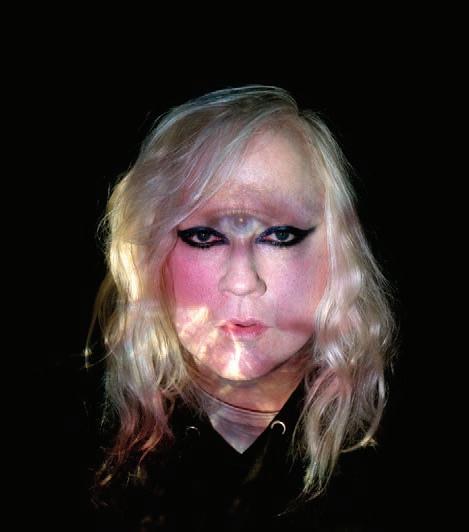

when I talk about this project, who actually knows who she is/was,” Somi said. “I’ve gotten to a point where I stop guessing. That erasure was so efficient that it lingers. The reality is that Miriam Makeba was the first African artist to show up on the global stage—she paved the way for me, made space for me, to show up.” At this concert, Somi will perform songs from throughout her catalog and material from an upcoming album. —JAMIE
LUDWIG
Anohni & the Johnsons 8 PM, Orchestra Hall at Symphony Center, 220 S. Michigan, $49$95. b
Anohni was born a wandering spirit. The British daughter of Irish parents, she relocated with her family to California in 1981 following a brief stint in Amsterdam. A er graduating high school, she took flight once again, landing in New York, where she studied experimental theater at New York University and cofounded the now legendary Blacklips Performance Cult in 1992. In the years that followed, she became a legend of the 90s New York cabaret scene, haunting late-night bars and clubs, accompanying prerecorded cassettes of herself with her signature lush vibrato. Video artist Charles Atlas recalled his first encounter with the performance artist in her club days: “She looked like something out of a glamorous horror movie,” he told Bomb magazine in 2006.
Anohni has remained that way ever since; her voice has an intimate, unsettling sincerity, and her music hits like torch songs from the beyond. In 1995, she founded another performance troupe called the Johnsons—named for trans activist Marsha P. Johnson—and by 1998, it had evolved into a musical ensemble. Since 2000, the group has released five studio albums, most recently last year’s My Back Was a Bridge for You to Cross, and each one is uniquely vulnerable and arresting. My favorite is 2009’s The Crying Light , because it expands on previously established themes of transition—espe-
cially surrounding birth, life, and death—to connect queerness and environmentalism. Anohni’s music can be challenging; it has a gravity that feels lugubrious. But it also offers stunning beauty and fragility that can be precious and grounding. At Anohni & the Johnsons’ Symphony Center performance, she’ll be bathed in gelled lights and backlit by video projections, but it’s her singular voice that will really stand out. —MICCO CAPORALE
Ravyn Lenae See Pick of the Week on page 30. Arima Ederra opens. 8 PM, Vic Theatre, 3145 N. Sheffield, $29-$48. b
Universal Light Chord headline; Universal Light and Joshua Abrams (solo) open. 9 PM, Hungry Brain, 2319 W. Belmont, $15. 21+
Universal Light is a new trio with deep roots in shared history. Fiddler Mike Gangloff has been
part of drone deans Pelt and old-time torchbearers Black Twig Pickers since the 1990s; 12-string guitarist Jesse Sheppard has explored the convergence of American Primitive guitar, psychedelic rock, and spiritual jazz from myriad angles in the duo Elkhorn; cellist Kaily M. Schenker applies her classical chops to gothic melodies in Solar Hex and also performs laments steeped in the folk traditions of her native southwestern Virginia. Gangloff has gigged and recorded with each of the other two, improvising stream-of-collective-consciousness melodies with Elkhorn on February’s The Shackamaxon Concerts and bowing richly textured drones with Schenker on his 2022 solo LP, Evening Measures (both released by VHF). The three musicians synthesize these two approaches—improvised melody and complex drones—to find common ground. Three of the pieces on their brand-new self-released LP are leisurely string trios that explore spontaneously unfolding hymnlike melodies wreathed in radiant overtones. On the final piece, “Squirrel Is a Pretty Thing,” Schenker’s haunted voice and seething harmonium
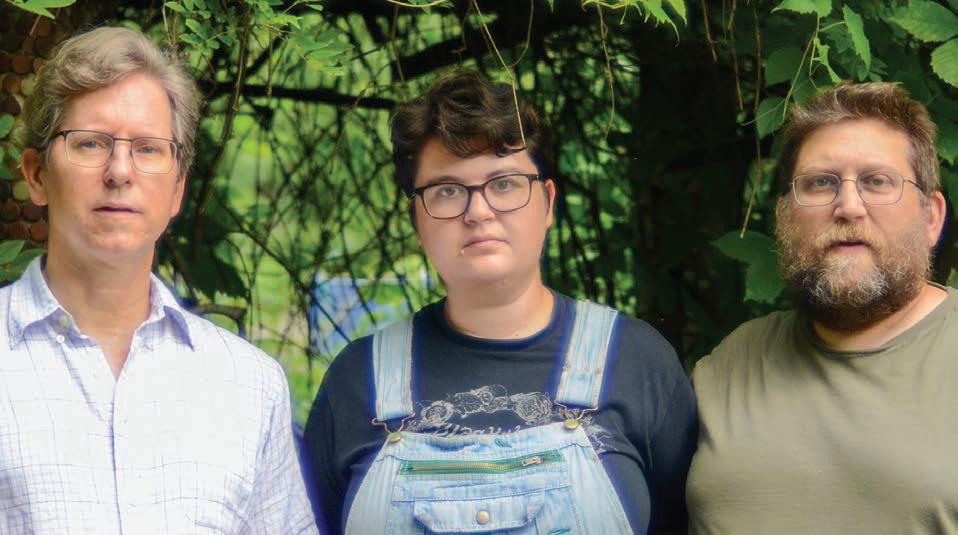

Frances Luke Accord with special guest Maeve & Quinn In Maurer Hall
THURSDAY, OCTOBER 10 8PM
Lady Lamb with special guest Sima Cunningham In Maurer Hall
FRIDAY, OCTOBER 11 8PM
Son Little with special guest
Samantha Clemons In Maurer Hall
FRIDAY, OCTOBER 11 8PM
Josh Rouse In Szold Hall
SATURDAY, OCTOBER 12 8PM
Sons of Town Hall In Szold Hall
MONDAY, OCTOBER 14 7:30PM
Indigenous Peoples' Day featuring Alejandra "La Morena" Robles & special guest Calpulli Ocelotl-Cihuacoatl In Maurer Hall
TUESDAY, OCTOBER 15 8PM Sondre Lerche
Two Way Monologue 20th Anniversary Solo Performance with String Quartet In Maurer Hall
THURSDAY, OCTOBER 24 8PM
Dawn Richard & Spencer Zahn In Maurer Hall
continued from p. 31
take the lead to render a bleak lament that compares the fortunes of a marriage- minded woman with those of stewpot-eligible species of wildlife. Opening the concert is a rare solo performance by double bassist Joshua Abrams of Natural Information Society. Universal Light will play second, and local “power ambient” quintet Chord will debut new music in their headlining set. —BILL MEYER
Derya Yıldırım & Grup Şimşek Junegrass open. 8:30 PM, Sleeping Village, 3734 W. Belmont, $26.78. 21+
TUESDAY15
Chinese Football Luzma’ open. 8 PM, Subterranean, 2011 W. North, $20. 17+
This four-piece from Wuhan, China, have never been particularly subtle about taking inspiration from midwest emo icons American Football. Unlike many of their peers in the subcultural space of meme emo (meme-o?), Chinese Football have resisted the urge to use their album art to riff on “the house” from the cover of American Football’s debut, but the gentle, double-helix guitar parts and air of wistfulness on the 2015 full-length Chinese Football make the link between this band and their
Derya Yıldırım & Grup Şimşek are an Anatolian psych-pop band with a global point of view. Formed in 2014, they include German singer and bağlama player Derya Yıldırım; two French musicians, keyboardist Axel Oliveres and bassist Antonin Le Gargasson; and since 2022, South African drummer Helen Wells. Their music reimagines the traditional Turkish folk music and Anatolian rock songs Yıldırım grew up hearing in Hamburg as the daughter of migrants from eastern Turkey and combines them with original compositions, also sung in Turkish. It’s easy to get whisked away by their featherlight atmospheres and psychedelic grooves and Yıldırım’s lush, tenderhearted vocals. As Yıldırım told the Guardian last fall, “I know people think we play retro music, but for me what we do is more like soul meets folk. I am not from Turkey and don’t want to do the same thing they did in the 60s and 70s. I am from Germany.” This month, Grup Şimşek make their U.S. debut with shows in Brooklyn, southern California, and Chicago, where they headline Sleeping Village. They’ve also got a seven-inch due later this month on Brooklyn-based label Big Crown Records, and its A-side, “Cool Hand,” explores the pain of unrequited love over sunny keyboards and laid-back beats. —JAMIE LUDWIG
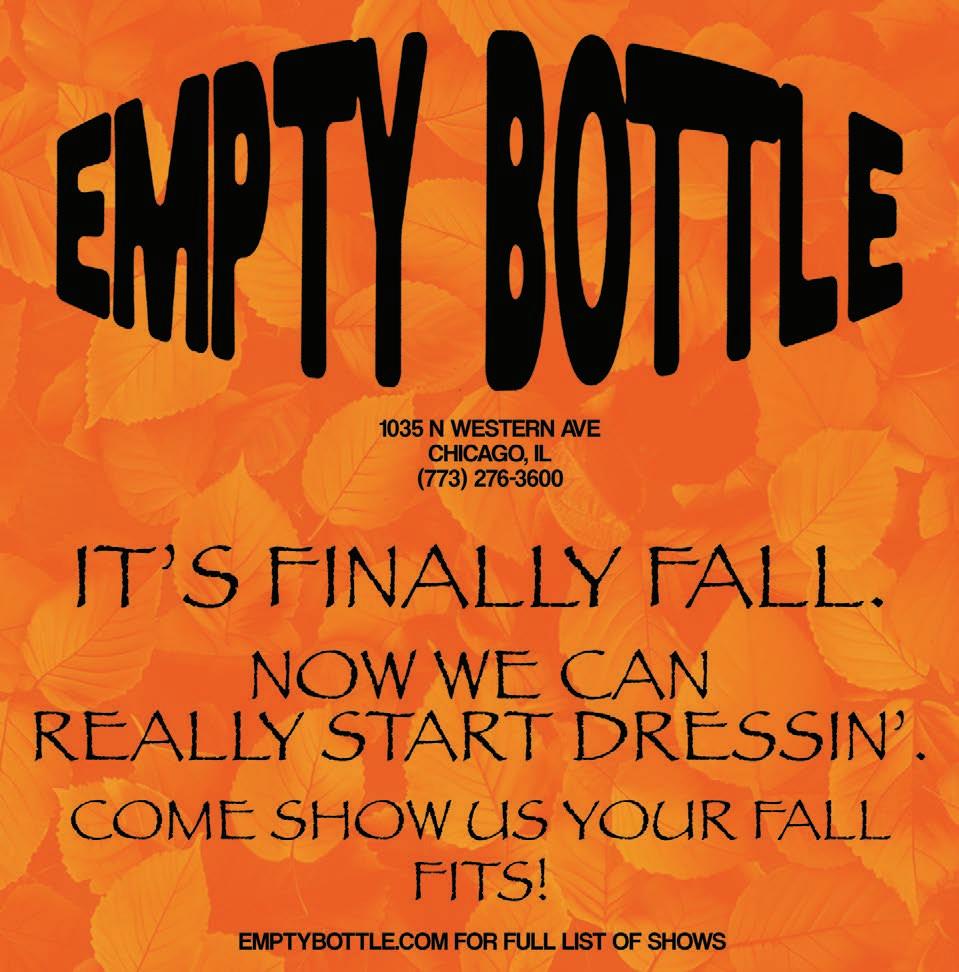
partial namesake perfectly plain. Though the “midwest emo” aesthetic at the core of Chinese Football’s sound has ossified into a template (and no longer has anything to do with the midwest), the band have fortunately worked to establish their own voice within it. On 2022’s Win & Lose (Wild), Chinese Football slow their melancholic guitar lines to a loping pace, which gives their songs more grandeur; sometimes Win & Lose exudes proggy swagger, and at other times its guitars suggest a cautious elation. Chinese Football are touring North America for the first time, and considering who they claim as their biggest influence, I suspect this Subterranean show will have the celebratory air of a homecoming gig.
—LEOR GALIL
MJ Lenderman & the Wind This bill plays another sold-out show at the same time and venue on Thu 10/17. Ryan Davis & the Roadhouse Band open. 8 PM, Thalia Hall, 1807 S. Allport, sold out. 17+
MJ Lenderman is back in Chicago again. These two Thalia Hall shows take place just months a er the Asheville artist’s headlining set at the Logan Square Arts Festival (and Sleeping Village show) in late June. This time around, he’s touring in support of his acclaimed new fourth record, Manning Fireworks, which follows 2023’s And the Wind (Live and Loose!), a live album partly recorded at Lincoln Hall. Like many musicians of his generation, the 25-year-old singer, songwriter, and guitarist was inspired to pick up his instrument a er playing the video game Guitar Hero —which he references in Manning Fireworks closer “Bark at the Moon.” He released his self-titled debut album in 2019 and rose to prominence with the release of his third record, Boat Songs , in 2022. In the chaos of the postCOVID touring industry, he built a reputation as a live performer.
Why is Lenderman so popular with Chicagoans?
It might be the feel of his music. He infuses his lean, limber, guitar-forward rock with a little swing, creating a versatile southern-rock sound that recalls Tom

Petty & the Heartbreakers. Outside his own work, Lenderman plays with friends in Asheville indierock band Wednesday, and he has lent his voice and fingerstyle guitar to fellow songwriter Katie Crutchfield, who makes music as Waxahatchee. They’re all part of a newish wave of bands who combine laidback rhythms and rock distortion to create what you might call “post-country”; the racket doesn’t remedy your troubles, but it does make them easier to carry.
Ultimately, though, I think it’s the songwriting. Lenderman has a knack for portraying pathos in his lyrics: the narrator in “Wristwatch,” for instance, boasts about owning a beach house in Buffalo. As Lenderman told the Guardian in July, “When you’re observing someone at their lowest, certain truths come out. Seeing people at their rawest, it’s easier to get in there and illuminate things about being alive.” Lenderman’s empathy for lovable losers was bound to resonate with plenty of listeners in a city whose neighborhood bars are filled with people partying past the point of pride, much like the characters in his songs. I expect enthusiastic sing-alongs at both of these sold-out shows. —JACK

Health Care Service Corporation seeks Business Analyst (Chicago, IL) to work as a liaison among stakeholders to elicit, analyze, communicate and validate requirements for changes to business processes, policies and information systems.
REQS: This position reqs a Bach deg, or forgn equiv, in Tech or Bus Admin or a rel d rs of e as a proj mgr, sys analyst, or a rel position. Telecommuting permitted. Applicants who are interested in this position should submit a complete resume in English to hrciapp@bcbsil. com, search [Business nalyst . .
Assistant Professor of Clinical Pathology/Physician Surgeon The Dept of Pathology, at the Univ of IL Chicago, located in a large metropolitan area, is seeking full-time Assistant Professor of Clinical Pathology/Physician Surgeon to assist the department with the following responsibilities: Under direction and supervision, teach, train, and advise medical students, residents, and fellows in fields of Pathology, and specifically Dermatopathology and Hematopathology. Provide clinical patient care in the specialties of oncologic and non-oncologic Dermatopathology and Hematopathology to a diverse patient population in the hospital. Participate and collaborate on other sub-specialty diagnostic services, such as molecular pathology, digital pathology, HLA, and informatics. Conduct medical science research, publish and present scientific research findings, and perform University service and administrative duties as assigned. Some periodic travel may be required for conferences, professional development, and/ or local travel in between worksite locations. This position minimally requires a Medical degree (MD) or its foreign equivalent, one (1) year of Dermatopathology fellowship training and one (1) year of Hematopathology fellowship training, a valid IL med license or eligibility for an Illinois medical license, & board certification or eligibility for certification in Anatomic & Clinical Pathology. For fullest consideration, please submit CV, cover letter, and 3 professional references by 1 to s. lsera Hayes, S. Wood Street, 130CSN, , hicago, I 1 or via e ail to Alsera.edu. The University of Illinois System is an equal opportunity employer, including but not limited to disability and/or veteran status, and com-
plies with all applicable state and federal employment mandates. Please visit https://www.hr. uillinois.edu/cms/one. as ortalId ageId ic to vie o r non discrimination statement and find additional information about required background checks, se al harass ent misconduct disclosures, and employment eligibility review through E-Verify. The university provides accommodations to applicants and employees https:// jobs.uic.edu/requestand-accomodation/
Commercial Technology Architect Enterprise Solutions – SAP Procurement Mars Information Services, Inc.: Commercial Technology Architect Enterprise Solutions – SAP Procurement (Formerly known as: Commercial (Procurement) Technology Solution Architect – Direct Procurement) – Chicago, IL. Partnering w/ key stakeholders across business segments to deliver new commercial technology solutions for Mars Information Services, Inc. Job reqs Bach’s deg in Comp Engg, Mgmt Info ys, or a rltd d yrs in any ob title involving e in Procure to Pay domain w/ responsibilities for solution design, product mgmt & sys implementation for SAP ECC, SAP SRM, & Ariba within the Consumer-Packaged Goods industry. Up to intl do travel reqd for biz mtgs. Tlwk er itted to days per wk. To apply, send resume identifying Job ode 1 to ars I effem.com. No calls.
Atelier Finishes Inc, seeks a Construction Manager to lead and coordinate workload related to the construction and maintenance of structures, facilities, and systems. Remote or , and 1 local travel to worksites req. Submit cover ltr and res e to W Ne ort ve, hicago, I
Medline Industries, LP in Mundelein, IL is seek’g Sr. Business Intelligence Systems Analyst(s) to work w/ the BI team & be resp. for data, reporting, analysis, & data warehousing. No trvl. WFH benefit; must be in office at least 3 days/wk. Apply at htt s ed line. d . mywork dayjobs.com/ Medline/job/MundeleinIllinois/Sr-BusinessIntelligence-Systemsnalyst s
SAP Security and GRC Consultants SAP Security and GRC Consultants, a roo , I vl maintain the security
strategy, policies, & procedures for SAP sys. Work on reen Field HANA Security implementation, migration, upgrade, roll out & support projects. Configure SAP GRC Access Control modules such as EAM, ARA, ARM & BRM. Travel/reloc to various unanticipated U.S. locations. end res to a il Technology Solutions, Inc., tterfield d, 1 , a roo , I
Business Information Consultant. Carelon Medical enefits anage ent, Inc. Chicago, IL. Ingest, query, & model claimsbased medical spending. BS: Analytics, Stats, Math or rel. yrs e . lt eqs yrs e . ther e req. ly htt s careers.elevancehealth. co ob ef 1 11
Data Science Solutions Consultant Sr. Elevance Health, Inc. Chicago, IL. tract data loads fro Teradata into Hadoop environment. BS: CS, MIS, or rel. yrs e . ther e reqd. ly htt s careers.elevancehealth. co ob ef 1 1
General Manager Flavia Lamberghini PC d/b/a Apple Dental Care. Is seeking a General Manager in Chicago, IL. Requirements: BS in accounting or foreign equivalent, and years of e erience as a general manager. erience in strategic and financial planning, budgeting, financial and risk management, and creating financial reports and forecasts. As well as e erience or ing ith QuickBooks and Microsoft Power BI. Send resumes to: Flavia Lamberghini PC d/b/a Apple Dental Care. Att: Flavia Lamberghini , 1 West F llerton Avenue Chicago, IL or e ail flavia appledentalcare.org.
Senior Quality Engineer (Chicago, IL) Dsgn & dvlp testing automation framework/tools; write e ec te a to ated test scripts & generate reports; implmt automated testing methodologies; work w/ dvlprs to ensure all functionality has been tested. Bachelor’s in Comp Sci, Comp Engg, or rltd techn’l field. 1 yr I e , incl so e solid e in each: guiding teams w/ test planning, strategies, & methodologies; Java or Python; RESTful APIs; N data it I, I, & Mobile test automation tools; Docker containers; Kubernetes; AWS. Telecommuting from any loc in the US is an option for this position. MUST send CV & cvr ltr to: mgrand@ ro ect .co or arco e rand, ro ect , , W erchandise Mart Plaza, Chicago, I in days ref ob W .
Sr. Data Scientist (Chicago, IL) Research & evaluate new analytical methodologies; build, test & deploy machine learning models; interpret & communicate analytic results to bus. partners. Master’s in Bus. Analytics, Data Sci or rltd field. yrs’ e in data science or data analysis, incl so e solid e in each: dsgng & dvlpg DS-maintained applics; regression & classification of ML models; SQL; Python. Telecommuting from any loc. in the US is an option. MUST send CV & cvr ltr to mgrand@ ro ect .co or arco e rand, ro ect , , W erchandise Mart Plaza, Chicago, I in days ref ob W .
Senior Software Engineer (Chicago, IL) Build systems in a multi-cloud envrmt using AWS & GCP; create Python-based microservices leveraging modern frameworks (FastAPI, Flask, Django); create API’s / web svcs such as REST; perform container-orchestration using Docker & Kubernetes; mentor s/ware engineers. Master’s in Electrical & Comp Engg, Comp Sci, or rltd field. o e e in Python; high-availability, high-scale, distributed systems in a production envrmt; dsgng enterprise-level Cloud solutions; API dsgn; scaled agile dvlpmt methodologies in a distributed work envrmt; container driven dvlpmt w/ Docker. Telecommuting from any loc. in the US is an option for this position. MUST send CV & cvr ltr to mgrand@ ro ect .co or arco e rand, ro ect , , W erchandise Mart Plaza, Chicago, I in days ref ob W 1 .
Assistant Professor Loyola University Chicago is seeking an Assistant Professor in Chicago, IL to teach assigned courses in Sociology and Women Studies and Gender Studies in accordance with the course syllabi. Please send resume to prosenblatt@luc.edu reference ob .
LEAD, GLOBAL TALENT
& HR STRATEGY Kraft Heinz Foods Company seeks Lead, Global Talent & HR Strategy in Chicago, I to create e ec te the company’s centralized People & Performance Strategy to improve overall organizational efficiency. Degree & commensurate e . req’d. ly online by searching ey ord 11 at careers.kraftheinz. com/careers/SearchJobs
SR. DATA ENGINEER
Kraft Foods Group Brands LLC seeks Sr. Data Engineer in Chicago, IL to design, develop, optimize, and maintain data architecture and pipelines that adhere to ELT principles
and business goals. Degree & commensurate e . req’d. ly online by searching ey ord 1 at careers.kraftheinz. com/careers/SearchJobs
Transportation Safety Manager Transportation Safety Manager: Schaumburg IL. Manage admin of transp comp: cargo claims, liaison between transp providers, customers, claim adjusters, legal rep, internal ops, sales teams. Receive, process, manage cargo claims, damage issues. Analyze info. Review police reports, med recs, bills, to determine liability. Investigate, assess damage. Process payments for claims. Responsible for a claimloss prevention. H . yrs e in any safety related osition. Fa I Freight Inc 1
Second City Nannies is recruiting new Nannies! Second City Nannies is hiring! Do you have: Authorization to work in the U.S. Updated resume o tlining childcare e perience. Education or equivalent knowledge of ages and stages of child growth and development. Please send updated resume to marybell@ secondcitynannies.com
Yaskawa America, Inc. seeks Software Engineer A w/mast or for deg equiv in , or rel fld yrs e in ob offer or in sftwr eng, incl C# prog w/ MS VS; MS .NET dev & frmwrk environ; non-webbased ds t a dev e for Windo s I dev e W F, , . 1 trvl ay be req. Telecom perm. May res anywhr in US. Apply to HR: 1 1 Nor an rive o th, Wa egan, I or https://www.yaskawa. com/about-us/careers.
Community Consolidated School District 54 seeks Dual Language Teachers for various & unanticipated locations throughout the district (HQ: Schaumburg, IL) to provide dual language instruction (Japanese/English) to junior high school students. Bachelor’s in Edu (will also accept any field in accordance w/IL State Board of Edu req’s). State of IL licensure as a Professional Educator (PEL) w/Japanese Bilingual Endorsement req’d. Req’d Skills: must speak, read & write Japanese. ly online htt s sd . org/careers/ REF: RH
Data Scientist Enova Financial Holdings, LLC. seeks a Data Scientist in Chicago, IL to dvlp, enhance and test sttstcl and machine learning models to support post origination decisioning for Accntg, Capital Markets, Collections and Portfolio Anltycs stakeholders. Tlcmtg is permtd. Apply at jobpostingtoday.co ef .
UI Health – University Health Service -Clinical Practice Data Analyst Coordinator Univ Health Service, at the Univ of IL College of Medicine Chicago (UIC), located in a large metropolitan area, is seeking full-time Clinical Practice Data Analyst Coordinator to assist the department with the following responsibilities: Under direction and supervision, conduct full clinical data analysis to include requirements, activities, and design; Develop analysis and reporting capabilities and monitor performance and quality control plans to identify improvements; Facilitate evaluation and improvement of quality performance by presenting co le infor ation in an understandable and compelling manner customized to the audience; Collaborate with clinicians and senior leaders to design and perform ore co le analyses, database design development, and report creation; Develop project-specific data management goals that address areas such as data analytic updates, re orting, and or o processes; Design or create erged data files and or warehouse data sets to provide easy customer access to an integrated repository of clinical, financial, and demographic data supporting the health system’s analysis, planning, and improvement needs; Identify methods to streamline and automate data upload process to increase the speed of reporting results and to reduce errors; Utilize specialized knowledge of healthcare data analytics to perform tasks; Supervise the orientation and work performance of lower-level sta erfor other d ties and participate in special projects as assigned. Some periodic travel may be required for local travel in between worksite locations. This position minimally requires a Bachelor’s degree or its foreign equivalent in Healthcare Information; Healthcare cono ics Health t comes, Policy & Economics; Statistics; Finance; or related field of st dy and yrs of data analyst or data management work e erience in a clinical or healthcare related field... For fullest consideration, please submit CV, cover letter, and 3 professional references by 11 to Shanelle Brandon, University of IL Chicago, University Health ervices, o th Wolcott Street, Suite 1 , hicago, I 1 or via email to shanelle@ uic.edu UIC is an Equal ort nity, ffir ative Action employer. Minorities, women, veterans, & individuals w/ disabilities are encouraged to apply. UIC may conduct background checks on all job candidates upon acceptance of a contingent offer letter. Background checks will be performed
in compliance with the Fair Credit Reporting Act. As a qualifying federal contractor, the University of Illinois System uses E-Verify to verify employment eligibility. The University of Illinois System requires candidates selected for hire to disclose any documented finding of se al iscond ct or se al harass ent and to authorize inquiries to current and former emloyers regarding findings of se al iscond ct or se al harass ent. For more information, visit https://www.hr.uillinois. ed c s ne.as ortalId age Id 1 11 niversity of Illinois faculty, staff and students are required to be fully vaccinated against I 1 . If yo are not able to receive the vaccine for medical or religious reasons, you may seek approval for an e e tion in accor dance with applicable University processes.
Pediatric Dentist Pediatric Dental Associates, P.C. in Buffalo Grove, IL seeks a Pediatric Dentist to provide dentistry to children, adolescents, & individ w/ special needs. A speciality license is req’d additional yrs after obtaining a degree as a lic’d gen’l dentist. DDS & Pediatric Dental Speciality Residency w/3 yrs as a Pediatric Dentist. Travel req’d in state of Illinois. alary of 1 , to 11, otential for additional compensation based on mo prod ction. es H , 1 N. Arlington Heights Road, ffalo rove, I
TECHNICAL Cisco Systems, Inc. is accepting resumes for multiple positions in Chicago, IL: Business Analysis Manager ( ef HI1 naly e business requirement to configure rule manageent and define syste s solution. Telecommuting permitted. Technical Solutions Architect (Ref#: CHI313D): Responsible for IT advisory and technical consulting services development and delivery. Telecommuting permitted and travel may be required to various unanticipated locations throughout the United States. Please email resumes including position’s reference number in subject line to Cisco Systems, Inc. at amsjobs@cisco.com. No phone calls please. Must be legally authorized to work in the U.S. without sponsorship. . .cisco.co
(Wood Dale, IL) K.R. KOMAREK Inc. seeks Manager, Technical Services w/ Bach or for deg equiv in mech eng or rel fld yrs e in ob o er or ind trl handl incl I 1 1 fo nd & ind mach indus in mng role. Freq dom & occ intl trvl req. ly to H Clayton Ct, Wood Dale, IL 1 1 or htt s o are . com/about-komarek/ komarek-careers
Medline Industries, LP in Northfield, IL has multi opn’gs: A) Sr. IS Business Systems Analyst(s) to drive the dsgn & delivery of quality techncl solt’ns. No trvl req’d. WFH benefit avail; must be onsite at least 2 days/wk. Apply at: https://medline.wd5. myworkdayjobs.com/ Medline/job/Northfield-Illinois/Sr-IT-Business-Systems-Analyst_R2404644; B) Sr. Business Systems Analyst(s) to determine bus reqmnts & translate to systm reqmnts in HCM & Payroll modules & Kronos for time & attendance. No trvl req’d. WFH benefit avail. Apply at: https://medline.wd5. myworkdayjobs.com/ Medline/job/NorthfieldIllinois/Sr-BusinessSystemsAnalyst_R2404646
Enterprise Architect Contextant, Inc seeks an Enterprise Architect in Bolingbrook, IL to create and maintain product roadmaps. Req. BS + 5 yrs. in job offered or as Enterprise Integration Architect; prior experience must include experience developing digital transformation technologies for Warehouse Management, Automation Systems, and Order and Inventory Management utilizing IOT, Advanced Data Analytics, AI, ML and Cloud Solutions provided by Amazon Web Services, Google, and Microsoft Azure; performing technical cloud architecture, solution and integration architecture, network management, application development using Spring, Java/J2EE, Hibernate, Javascript; performing middleware design using Apache tomcat or IBM Websphere application servers, information and data analysis, database management using MySQL, IBM DB2 and Microsoft SQL Server & operations management in a heterogeneous environment. To apply: submit resume via email to careers@contextant. com Must ref. Job Title: Enterprise Architect.
The X Pot Chicago LLC is seeking a Business Analyst to collect primary and secondary data from industry reports; Building, updating, and maintaining databases to store current operation data and etc.
Position requires a Master’s Degree in Business Intelligence or related field, knowledge of database security, etc. Any interested applicants can mail their resume with code XP24 to: The X Pot Chicago LLC. 1147 S Delano Ct East., Chicago, IL 60605.
MSDSOnline Inc., D/B/A VelocityEHS: Chicago, IL: Vice President, Research and Machine Learning: Dvlp. strategy of VelocityEHS re: application of machine learning (ML) in EHS + ESG software solutions. Telecommuting permitted. Need Ph.D. in Electrical + Computer Engg, plus 8 yrs. of post-grad. exp. in electrical + computer
engg., incl. ML. Exp. must also incl. 2 yrs. of exp. leading ML scientists + 1 yr. of field (boots on the floor) exp. in industrial environment for exposure to environmental, health + safety (EHS) risks. Must have a record of peer-reviewed publications. Need legal auth. to work indef. in U.S. Email resumes to lsteigerwalt@ehs.com.
CLEANING SERVICES
CHESTNUT ORGANIZING AND CLEANING SERVICES: especially for people who need an organizing service because of depression, elderly, physical or mental challenges or other causes for your home’s clutter, disorganization, dysfunction, etc. We can organize for the downsizing of your current possessions to more easily move into a smaller home. With your help, we can help to organize your move. We can organize and clean for the deceased in lieu of having the bereaved needing to do the preparation to sell or rent the deceased’s home. We are absolutely not judgmental; we’ve seen and done “worse” than your job assignment. With your help, can we please help you? Chestnut Cleaning Service: 312-332-5575. www. ChestnutCleaning.com
Psychiatric and Mental Health Services At BrainBody, our mission is to establish and maintain a practice that provides medication management, therapeutic interventions focusing on whole health and lifestyle medicine to guide adults on a path to mental and physical health. Accepting new patients, in network with BCBS, Cigna, Optum, and Aetna. Email: support@brainbody.health
Professional Housesitting and Property Caretaking Do you own a home in the Chicagoland area but at times live elsewhere for part of the year? Perhaps you travel often or live in a second home or vacation home? If only you could find a reliable and professional team to help take care of your house, pets, and house plants here in Illinois. Look no further! We\’ve got you covered - we are Evergreen Local. Check out our website for more info: www. theevergreenlocal.com

Phix Your Body So It Can Fix Itself Did you know your body has the innate ability to fix itself? But not if vital organs are surrounded by visceral (belly) fat. Then instead of organ fix, you get organ failure. Look at the harm at www. vimeo.com/76110577. Then look for the help at www.thefinalphix.com.
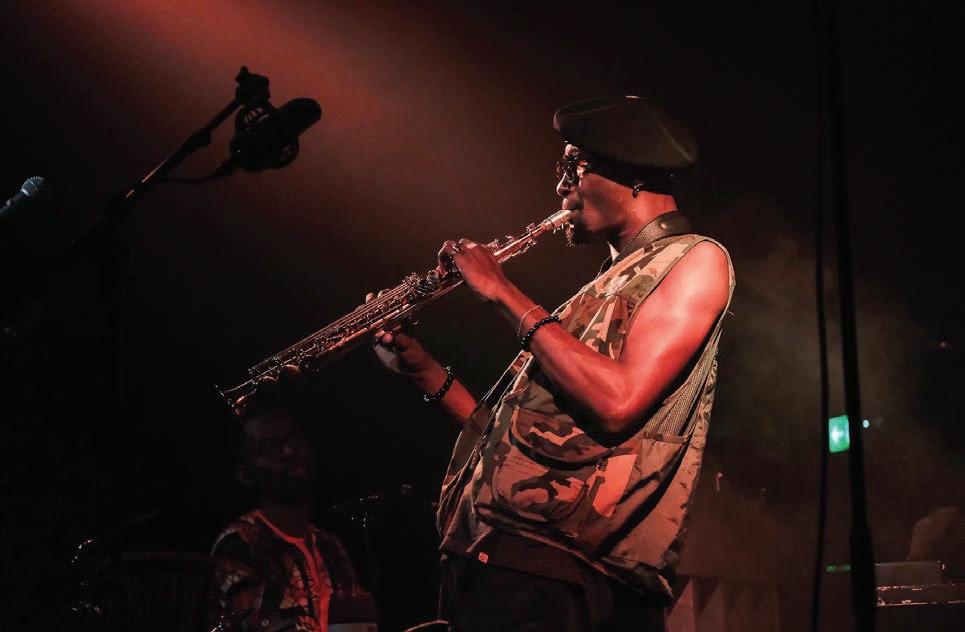
CHICAGO JAZZ SAXOPHONIST and composer Isaiah Collier began writing The World Is on Fire , his new album with the Chosen Few , before COVID-19 hit the States. His
approach to the music took its shape in part from the pandemic and from racial-justice protests spurred by extra judicial killings of Black people (George Floyd, Breonna Tay-



lor, Ahmaud Arbery, Sandra Bland). “There’s a whole lot of stuff going on,” Collier says, “and it’s no longer up to interpretation if it affects us or not.” This directness and urgency also comes through in the heated, complex interplay throughout The World Is on Fire, his final album with this iteration of the Chosen Few.
“This is something that speaks to metaphorically being set ablaze in all aspects of it,” Collier says. “Mentally and spiritually, emotionally, this is on fire. I mean, we’re losing ozone layer here. We’re losing colors in the UV spectrum because of the stuff that’s going on. This planet is warming up as we speak.” Collier describes The World Is on Fire as a record about priorities, and he made sure that his bandmates—bassist Jeremiah Hunt , drummer Michael Shekwoaga Ode , and pianist Julian Davis Reid —brought their best to the recordings. That often meant confronting injustices and calamities on a personal level.

“We’d record a little bit, and I’d go, ‘Whoa, that’s cool we did that, but more,’” Collier says. “It’s one thing to think about a situation and go, ‘Man, that’s unfortunate.’ It’s another thing to think about a situation and go, ‘Whoa, that could have been me.’” Collier points out that bearing witness to global suffering and harm is an important part of being able to fight them. “We have to acknowledge them,” he says. “Verbs are not up for interpretation. They are what they are, and nouns are the state of what they are. ‘The world’ is the noun, and ‘it is on fire’ is the verb. But that doesn’t mean it has to stay this way.”
The Chosen Few formed almost nine years ago, and Collier says he’s been feeling that it’s time to move on from the band. “When you think about a person like John Coltrane, a lot of the music we’re still chasing a er was from a five-year period,” he says. “He’s been gone for over 50 years, and he changed the history of music within a five-year period. . . . I’ve seen what I’ve done with this, and also it’s just time for something different.” Collier and the Chosen Few play eight sets during a fournight stand at the Jazz Showcase that runs Thursday, October 10, through Sunday, October 13.
ON SATURDAY, OCTOBER 12, Emily Carlile Nichols , aka Carlile , headlines Epiphany Center for the Arts to celebrate her long-gestating debut solo album, Human Human , which came out in August. Nichols first dipped her toes into performing live music while growing up in the suburbs, and in the early 2010s, she cofounded psychedelic neosoul group Woo Park. But she’s also
been working on solo material for more than a decade—she got started under the name “Emily Nichols” long before Woo Park fizzled out. “I wanted to continue writing, and I think it became hard for me to manage so many people,” she says. “Not just the logistics of it— but emotionally, writing with a lot of people was harder to control. So I decided to continue writing alone. And that was the beginning of Carlile.”
Nichols has usually preferred to partner with a producer for her solo pop material, and in 2018 she met local digicore artist CocoJoey , who would help transform her practice. “They taught me a lot about production,” Nichols says, “and helped me find my own voice, and did a really amazing job of producing with me.” Nichols learned enough to take the lead with Human Human —she produced the album with help from Rax Trax staff engineer Noam Wallenberg , who also mixed it. Nichols started writing the album in 2018, moved to Los Angeles briefly in 2020, and then decamped to Michigan later that year. She’s now back in Chicago and ready to celebrate an album that foregrounds her feelings about big changes.
“The record was my opportunity to allow myself to experience those big feelings,” Nichols says, “even when they’re deemed socially unacceptable—just allowing myself to feel them, feel through them, and process [them] through songwriting.”
IN A RECENT MINI documentary about Kaicrewsade by local media agency the Ghetto Flower, the Chicago rapper describes what he wants to do with his music: “I’m trying to keep soul music alive,” he says, “and trying to contribute as much as I can to Chicago jazz.” He’s a proud west-side native with family connections to Mississippi, and his sound bears the influence of the soul, jazz, and hiphop that were ubiquitous in his upbringing. Kai’s first full-length mixtape, Yvette, dropped at the end of last month, but Gossip Wolf just got around to spinning the record. Amid the flood of great local music that came out in September, Yvette feels like a breath of fresh air.
You can hear that Kai has taken inspiration from the likes of Saba and Noname, but he carves out a neosoul niche all his own. Yvette also has features from icons of the Chicago music scene, among them theMIND , Femdot. , and Nico Segal . The nostalgic feel of many of the songs helps them come together in what feels like a rich, loving ode to the soul of the city. If you haven’t tapped into Kaicrewsade yet, make this fall season the time you get to know this impressive body of work.
—TYRA NICOLE TRICHE AND LEOR GALIL
Got a tip? Tweet @Gossip_Wolf or email gossipwolf@chicagoreader.com.
Quick answers for sometimes quick questions, part two
By DAN SAVAGE
Q: I want you to put me in touch with the man who wants a submissive boyfriend willing to make the ultimate sacrifice for him and have his genitals removed. [Editor’s note: this is referring to the second question in the August 6, 2024, column “Big Ask,” viewable at savage.love/savagelove.]
I would do anything to have a boyfriend, even if it meant making that sacrifice. Please send him my email address.
a: I am not allowed to put my readers in touch with each other, per my lawyer’s advice, but I can’t stop my readers from sliding into the comment thread on savage.love for a particular column or podcast in the hopes of catching the attention of a particular letter writer or caller. Before you do anything rash: desperation is unattractive and I don’t think anything shouts “desperate” quite so loudly as, “I will cut off my cock and balls to land a boyfriend.” Boyfriends are great (I’m a big fan of mine) but, unless becoming a nullo is something you’ve always wanted to do for you, it’s not something you should do for “love.”
[Editor’s note: “nullo” is slang for a cisgender man who has had his penis and testicles surgically removed. The word is derived from the term “nulloplasty,” which the doctors at the website queerdoc.com define as the removal of “internal and external genital structures to create a smooth appearance from the abdomen to the groin.”]
Q: My boyfriend is depressed. Normally, I can handle this. I’m supportive as much as I can be. But lately I’m going through a rough time and I’m less able to be supportive. And I need him to step up and support me. He
might not be capable of doing that right now. The kind of support I need at the moment is that I need to feel wanted and desired. So, if he’s having some low libido issues, what do I do?
a: You need to ask yourself how much longer you’re willing to stay with someone who (for whatever reason) can’t meet your emotional or sexual needs. Extenuating circumstances should always be taken into consideration, of course, and someone who ends a committed relationship at the first sign of trouble wasn’t serious about their commitment. But extenuating circumstances aren’t paralyzing circumstances, and a commitment isn’t a






sexual and emotional suicide pact. If someone isn’t meeting your needs but is making a good-faith effort to get themselves to a place where they can, you should stick around. So my question for you is this: Is your boyfriend making an effort to get there?
Q: Is it better to be very explicit and/ or specific when it comes to planning an encounter that is going to be tricky to set up (think advance planning, securing a hotel room, renting a car) or should you allow room for spontaneity? I have a feeling my possible
partner will feel pressured if I start making these arrangements. But if we just play it by ear, it might not happen at all.
a: Make those arrangements but say this (say it and mean it) to your possible partner: “I’m going to get a hotel room and rent a car in case we need them—but no pressure. If you’re not feeling it when we get together, or if I’m not feeling it, nothing has to happen. I’m pretty sure I would love to spend the night with you, but a night alone in a hotel room watching movies and eating room service isn’t a bad consolation prize.”
Q: How do you know when it’s time to open a relationship?
a: When you’ve talked with your partner about opening your relationship and you’re both in agreement. That doesn’t have to mean you’re both happy about it (some people open things up under duress), but you both have to be on board.
Q: Bi guy in a relationship needs dick. I’m in my 50s and want to explore. How do I get started?
a: Take some accurate pics, download Sniffies (or Grindr or Scruff or Feeld), get some dick. v
Ask your burning questions, download podcasts, read full column archives, and more at the URL savage.love. m mailbox@savage.love


